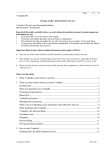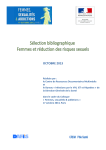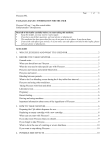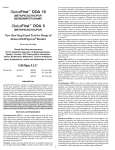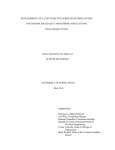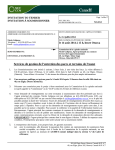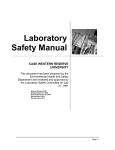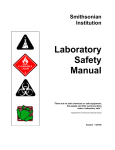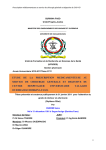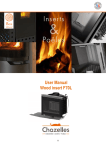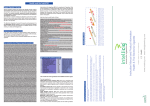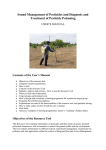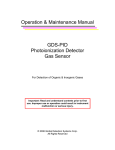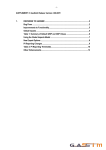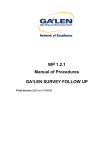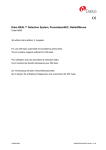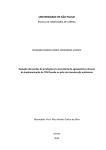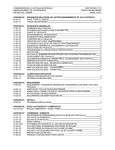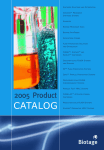Download Laboratory Manual - South Dakota State University
Transcript
South Dakota State University Electrical Engineering and Computer Science Laboratory Safety and Operations Manual Prepared by Jason Sternhagen September 21, 2015 1 Contents 1 2 Introduction ............................................................................................................................. 8 1.1 Objectives ......................................................................................................................... 8 1.2 Laboratory Overview ....................................................................................................... 8 1.3 Laboratory Safety Training .............................................................................................. 9 1.4 Roles and Responsibilities ............................................................................................... 9 1.4.1 Laboratory Manager.................................................................................................. 9 1.4.2 Faculty/ Principal Investigator ................................................................................ 10 1.4.3 SDSU Environmental Health and Safety (EHS) ..................................................... 10 1.4.4 Laboratory Researcher/ Student .............................................................................. 10 Emergency Procedures ...........................................................................................................11 2.1 Introduction .....................................................................................................................11 2.2 Fire ..................................................................................................................................11 2.3 Medical Emergencies ..................................................................................................... 12 2.4 Chemical Exposure ........................................................................................................ 12 2.4.1 Skin or Clothing ...................................................................................................... 12 2.4.2 Eyes ......................................................................................................................... 12 2.4.3 Hydrofluoric (HF) Acid .......................................................................................... 13 2.5 Electric Shock ................................................................................................................ 14 2.6 Toxic Gas Alarm............................................................................................................. 14 2.6.1 Yellow Toxic Gas Alarm ......................................................................................... 14 2.6.2 Red Toxic Gas Alarm .............................................................................................. 15 2.7 3 Reporting Accidents, Injuries, and Near Misses ............................................................ 15 Chemical Hazard Identification ............................................................................................ 15 3.1 Introduction .................................................................................................................... 15 3.2 Laboratory Chemical/ Materials Labeling Requirements Policy ................................... 15 3.3 Material Safety Data Sheet (MSDS) .............................................................................. 16 3.4 Globally Harmonized System (GHS)............................................................................. 16 3.4.1 Physical Hazards ..................................................................................................... 16 3.4.2 Health Hazards ........................................................................................................ 17 3.4.3 Environmental Hazards ........................................................................................... 18 2 3.5 4 5 6 7 Other Chemical Safety Resources .................................................................................. 18 Health Hazards of Chemicals................................................................................................ 19 4.1 Introduction/ Basic Toxicology ...................................................................................... 19 4.2 Methods of Entry............................................................................................................ 20 4.2.1 Skin and Eye Contact .............................................................................................. 20 4.2.2 Inhalation ................................................................................................................ 20 4.2.3 Ingestion .................................................................................................................. 21 4.2.4 Injection .................................................................................................................. 21 Controlling Chemical Exposure ............................................................................................ 21 5.1 Introduction .................................................................................................................... 21 5.2 Engineering Controls...................................................................................................... 21 5.2.1 Fume Hoods ............................................................................................................ 21 5.2.2 Glove Boxes ............................................................................................................ 22 5.3 Work Practices ................................................................................................................ 22 5.4 Administrative Controls ................................................................................................. 22 5.5 Personal Protective Equipment (PPE) ............................................................................ 22 5.5.1 Skin Protection ........................................................................................................ 22 5.5.2 Eye Protection ......................................................................................................... 22 5.5.3 Inhalation Protection ............................................................................................... 22 Suspected Exposure .............................................................................................................. 23 6.1 Criteria for Suspected Exposure to Toxic Substances .................................................... 23 6.2 Exposure Assessment ..................................................................................................... 23 Safe Work Practices and Procedures ..................................................................................... 23 7.1 Introduction .................................................................................................................... 23 7.2 Standard Operating Procedures ...................................................................................... 24 7.3 Personal Behavior .......................................................................................................... 24 7.4 Unattended Experiments ................................................................................................ 25 7.5 Working Alone ............................................................................................................... 25 7.6 Fume Hoods ................................................................................................................... 25 7.7 Transporting Chemicals ................................................................................................. 25 7.8 Mixing Chemicals .......................................................................................................... 26 3 7.9 Chemical Storage ........................................................................................................... 26 7.9.1 Introduction ............................................................................................................. 26 7.9.2 Inventory ................................................................................................................. 27 7.9.3 Separation and Segregation of Chemicals .............................................................. 28 7.9.4 Incompatibility of Chemicals .................................................................................. 29 7.9.5 Flammable Liquids ................................................................................................. 29 7.9.6 Peroxide Forming Compounds and Reactives ........................................................ 29 7.9.7 Perchloric Acid........................................................................................................ 29 7.9.8 Unstable Materials and Chemicals.......................................................................... 29 7.10 Compressed Gases Handling ...................................................................................... 30 7.10.1 Compressed Gas Risks:........................................................................................... 30 7.10.2 Compressed Gas Precautions .................................................................................. 30 7.10.3 Connecting a Pressure Regulator ............................................................................ 30 7.10.4 Regulator Precautions ............................................................................................. 31 7.11 Toxic Gases .................................................................................................................... 31 7.11.1 Special Pyrophoric/ Flammable Gas Requirements ............................................... 31 7.11.2 Fittings, Valving, and Piping ................................................................................... 32 7.11.3 Purging and Venting ................................................................................................ 33 7.11.4 Excess Flow Control ............................................................................................... 33 7.11.5 Fasteners used to Assemble Vacuum Equipment .................................................... 33 7.11.6 Toxic Gas Cylinder Change out Procedures ........................................................... 33 7.12 Cryogenics .................................................................................................................. 33 7.12.1 Introduction ............................................................................................................. 33 7.12.2 Personal Protective Equipment (PPE) .................................................................... 33 7.12.3 Dispensing Liquid Nitrogen into Dewars ............................................................... 33 7.12.4 Transporting Liquid Nitrogen in Dewars ................................................................ 34 7.13 7.13.1 7.14 Electrical Safety.......................................................................................................... 34 Introduction ............................................................................................................. 34 Chemistry and Microelectronics Laboratory Equipment ........................................... 34 7.14.1 Introduction ............................................................................................................. 34 7.14.2 Refrigerators and Freezers ...................................................................................... 34 4 7.14.3 Stirring and Mixing Devices ................................................................................... 34 7.14.4 Heating Devices ...................................................................................................... 34 7.14.5 Ultrasonic Devices .................................................................................................. 35 7.14.6 Vacuum Equipment ................................................................................................. 35 7.14.7 Glassware ................................................................................................................ 35 7.14.8 Compressed Air Guns ............................................................................................. 35 7.14.9 Ultraviolet Lamps ................................................................................................... 36 7.15 8 Machine Power Tools ................................................................................................. 36 7.15.1 Benchtop Abrasive Wheel Grinder ......................................................................... 37 7.15.2 Handheld Abrasive Grinder .................................................................................... 38 7.15.3 Benchtop Belt/ Disk Sander .................................................................................... 38 7.15.4 Drill Press................................................................................................................ 38 7.15.5 Circular Wood Saw ................................................................................................. 39 7.15.6 Circular Metal Saw ................................................................................................. 39 7.15.7 Miter Saw ................................................................................................................ 40 7.15.8 Jig Saw .................................................................................................................... 40 7.15.9 Metal Lathe ............................................................................................................. 40 7.15.10 Soldering Irons .................................................................................................... 41 7.15.11 Heat Guns ............................................................................................................ 41 7.15.12 Ladders ................................................................................................................ 41 7.15.13 Hand Tools .......................................................................................................... 42 7.16 Laser Safety ................................................................................................................ 42 7.17 Trailer Safety .............................................................................................................. 42 7.18 Particularly Hazardous Substances ............................................................................. 43 7.18.1 Introduction ............................................................................................................. 43 7.18.2 Carcinogens............................................................................................................. 43 7.18.3 Reproductive toxins ................................................................................................ 44 7.18.4 Substances with high acute toxicity ........................................................................ 44 Chemical Spills ..................................................................................................................... 44 8.1 Introduction .................................................................................................................... 44 8.2 Cleanup Methods............................................................................................................ 45 5 8.3 9 Laboratory Waste Disposal ................................................................................................... 45 9.1 Introduction .................................................................................................................... 45 9.2 Chemical Waste Pickup .................................................................................................. 45 9.3 Liquid Waste................................................................................................................... 46 9.3.1 Sanitary Sewer Disposal ......................................................................................... 46 9.3.2 Acids ....................................................................................................................... 46 9.3.3 Bases ....................................................................................................................... 46 9.3.4 Solvents ................................................................................................................... 46 9.3.5 Other Liquids Requiring Individual Waste Containers ........................................... 47 9.4 10 Solid Waste ..................................................................................................................... 48 Chemical Specific Issues ...................................................................................................... 48 10.1 12 HF Acid Spills ................................................................................................................ 45 Hydrofluoric (HF) Acid .............................................................................................. 48 Disciplinary Actions.............................................................................................................. 50 12.1 First Offense ............................................................................................................... 50 12.2 Second Offense ........................................................................................................... 50 12.3 Third Offense .............................................................................................................. 50 13 Appendix A: Incompatible Materials .................................................................................... 51 14 Appendix B: Particularly Hazardous Materials .................................................................... 54 14.1 A ................................................................................................................................. 54 14.2 B.................................................................................................................................. 55 14.3 C.................................................................................................................................. 55 14.4 D ................................................................................................................................. 57 14.5 E .................................................................................................................................. 59 14.6 F .................................................................................................................................. 59 14.7 G ................................................................................................................................. 59 14.8 H ................................................................................................................................. 60 14.9 I ................................................................................................................................... 60 14.10 J ................................................................................................................................... 60 14.11 K ................................................................................................................................. 61 14.12 L .................................................................................................................................. 61 6 14.13 M ................................................................................................................................. 61 14.14 N ................................................................................................................................. 62 14.15 O ................................................................................................................................. 64 14.16 P .................................................................................................................................. 64 14.17 Q ................................................................................................................................. 65 14.18 R.................................................................................................................................. 65 14.19 S .................................................................................................................................. 65 14.20 T .................................................................................................................................. 65 14.21 U ................................................................................................................................. 66 14.22 V ................................................................................................................................. 66 14.23 W ................................................................................................................................ 66 14.24 X ................................................................................................................................. 67 14.25 Y ................................................................................................................................. 67 14.26 Z .................................................................................................................................. 67 14 Appendix C: Laboratory Inspection Checklist .................................................................... 68 15 Appendix D: Incident Report Form ..................................................................................... 73 16 Appendix E: SOP Template ................................................................................................. 76 17 References ............................................................................................................................. 78 7 1 Introduction 1.1 Objectives The goal of the safety program and this manual is to reduce the risk of injury or illness to laboratory workers by ensuring that they have the training, information, support, and equipment needed to work safely in the laboratory. This document is a work in progress and not 100% comprehensive. It is up the user to determine if their work procedures are appropriate and safe. This laboratory manual is a summary of the best practices obtained from the literature listed in the references. 1.2 Laboratory Overview The 3350 ft2 microelectronics laboratory consists of five laboratory bays, five service chases, a support room, and a gowning room. • • • • • Bay 1: Organic Electronics o Braun MB20 glovebox for organic electronics, atomic force microscope, and associated electronic instrumentation. o Two fume hoods for cleaning and preparation of electronic materials o Diamond and wire saws o Tube furnace and vacuum oven o Thick film printer Bay 2: Characterization o Hitachi Scanning Electron Microscope (SEM) o Energy Dispersive X-ray (EDX) analysis system o Dektak Veeco 150 stylus profilometer o CRC-150 sputter coater for SEM sample preparation Bay 3: Film Deposition Bay 1 o Rapid Thermal Processing (RTP) o Trion II plasma etcher o Torr IBAD thin film deposition system (ion beam, e-beam, evaporative, and sputter) o Torr Combination thin film deposition system (evaporative and sputter) o Torr high temperature chemical vapor deposition (CVD) system o Plasmatherm plasma enhanced large area chemical vapor deposition (CVD) system. Bay 4: Film Deposition Bay 2 o Wintek plasma enhanced chemical vapor deposition (CVD) system o Picosun atomic layer deposition (ALD) system o Fume hood for cleaning and preparation of electronic materials o KJL thin film sputter deposition system with load lock for rapid sample transfer o Kulicke and Soffa gold ball bonder Bay 5: Lithography o Yellow and red darkroom lighting 8 o o o o o o o De-ionized water system Substrate spin dryer VCA2000 contact angle measurement system Substrate spin coater in laminar flow hood Kasper mask aligner and UV light source in laminar flow hood CVC evaporative and sublimation thin film deposition system Fume hood for cleaning and preparation of electronic materials 1.3 Laboratory Safety Training Each of the microelectronics laboratories poses some risk to the user due to hazardous materials and/ or equipment. Therefore, all laboratory users including faculty, staff, and students are required to complete the following training: • • EE&CS Laboratory Safety: This course is conducted by the EE&CS laboratory manager and will be offered every fall. Additional dates will be offered as needed for new students. Attendance for this course is required every year. Contact the laboratory manager or faculty for additional information. EHS Chemical Hygiene and Laboratory Safety Class: This course is offered periodically throughout the year through the SDSU Environmental Health and Safety office. Attendance for this training is required only once. Students must attend this training at the earliest opportunity. Students who are utilizing particularly hazardous materials but have not completed EHS training must be supervised by a trained student or faculty when working in the laboratory. Registration for this course is online through InsideState. Contact the EHS office for training dates or additional information (605-688-4264 [email protected]). 1.4 Roles and Responsibilities 1.4.1 Laboratory Manager The laboratory manager has the following responsibilities: • • • • • • • • • Facilitate safe and effective use of the laboratory. Document new procedures and protocols as developed by the faculty/ principal investigators. Ensure that all users attend annual EE&CS safety training Ensure that all users attend EHS chemical training. Maintain records of safety training. Ensure that all users observe the guidelines outlined in this manual. Review and approve use of particularly hazardous substances (Appendix E. Day to day management of the laboratory. Oversee the development of standard operating procedures (SOP) for particularly hazardous materials. 9 • Periodic safety inspections of the laboratory (checklist is located in Appendix C). 1.4.2 Faculty/ Principal Investigator The faculty/ principal investigator has the following responsibilities: • • • • • • • The faculty/ principal investigators are the subject matter experts and are responsible for developing new procedures, protocols, and standard operating procedures (SOPs). Ensure that the laboratory researcher/ student understands how to safely work with chemicals Provide chemical and procedure-specific training as needed Provide laboratory researchers/ students with appropriate engineering controls and personal protective equipment as necessary to work safely and to ensure that this equipment is used safely Ensure that laboratory researchers/ students complete and submit “Particularly Hazardous Approval” forms for approval before using any particularly hazardous substances Assist in the development of operating procedures for particularly hazardous materials. Review and approve work with particularly hazardous substances 1.4.3 SDSU Environmental Health and Safety (EHS) SDSU Environmental Health and Safety (EHS) office has the following responsibilities: • • • • • • • • • General safety for all campus occupants Guidelines for general laboratory safety, both research and teaching Specific guidelines for special purpose or particularly hazardous environments Management of hazardous materials including usage, storage, and disposal Evaluation of high hazard areas and chemicals in conjunction with building codes Management of the SDSU Radiation Safety Program Recycling of materials including: chemicals, used oil, fluorescent bulbs and ballasts, electronic components including computers, printers, etc Indoor air quality investigations and mitigation in conjunction with Facilities and Services Coordinate with Emergency Management on planning for campus emergencies 1.4.4 Laboratory Researcher/ Student The laboratory researcher/ student has the following responsibilities: • • • • Do not perform any task unless you are properly prepared!!! Attend EE&CS laboratory safety training every year Attend EHS chemical hygiene and laboratory safety training as soon as is possible Follow all procedures and practices as outlined in this manual and as directed from supervisors/ faculty/ principal investigators 10 • • • • • • • • • 2 Log in and out when entering or leaving the facility Report all injuries, accidents, or near misses to the cleanroom manager and faculty/ principal investigator. Assist in the development of operating procedures for particularly hazardous materials. Participate in weekly cleaning of the laboratory. Know what the alarms mean in your work area. If an alarm goes off, try to find out why. See if there is anything you can do to help. Notify lab manager or faculty immediately. Don’t ignore or just turn off the alarm. When you have the slightest doubt about anything, ASK the laboratory manager or faculty or equipment principle user. It is better to ask questions than damage expensive equipment or risk personal injury. Report unsafe practices to the laboratory manager and the faculty. Report any equipment malfunctions to the laboratory manager. Clean all equipment after you are done using it. Do not use solvents or methods which will damage the equipment. Emergency Procedures 2.1 Introduction All emergencies must be immediately reported by calling: 111 or 605-688-5117. A phone is located along the south wall of the cleanroom in Bay 3. When calling, be sure to: • • • • • Identify yourself State the location of the incident Clearly indicate to the dispatcher what services are required (ie. EHS, fire, medical, etc) Do not hang up until told to do so by the dispatcher If laboratory or building evacuation is required, pull the fire alarm All accidents, injuries, or near misses must be reported to the laboratory manager and to the principal investigator/ faculty. 2.2 Fire • • • • Evacuate the area and pull the fire alarm immediately. Fire alarms are located: o Cleanroom gowning room. o East, west, and center stairwells of each floor. o All exterior doors. Call 111 or 605-688-5117 to report the fire. If your clothing catches fire, drop to the floor and roll to smother the fire. 11 • • • • • If a coworker’s clothing catches fire, get the person to the floor and roll him/ her to smother the fire. Laboratory users are not required to fight fires. However, small fires approximately the size of a garbage can, may be fought with a fire extinguisher. If a fire is larger than a garbage can or spreading, activate the fire alarm and evacuate the building. If the fire alarm sounds while you are in the laboratory, leave immediately without removing the cleanroom apparel and exit the building via the stairs. All accidents, injuries, or near misses must be reported to the laboratory manager and to the principal investigator/ faculty. 2.3 Medical Emergencies • • • In the event of injury or illness where assistance is necessary, call 111 or 605-688-5117 A first aid kit is located in the gowning room. This kit shall include: o Basic bandages, sterile gauze, and tape o Sterile examination gloves o Mask for mouth to mouth resuscitation o Spill kit with disinfectant for the cleanup and disposal of blood, vomit, or other bodily fluids All accidents, injuries, or near misses must be reported to the laboratory manager and to the principal investigator/ faculty. 2.4 Chemical Exposure 2.4.1 • • • • • • • 2.4.2 • Skin or Clothing Immediately flush the affected area with water for a minimum of 15 minutes. In the event of skin contact, flush with water for at least 15 minutes. Remove contaminated clothing while rinsing. Seconds count; do not worry about modesty. Alert laboratory personnel of the incident and get medical attention based on MSDS/ GHS recommendation. Discard or separately launder contaminated clothing. Clothing that cannot be decontaminated shall be discarded. Contact EHS for instructions regarding the disposal of clothing contaminated with particularly hazardous materials. If assistance is necessary, call 111 or 605-688-5117. All accidents, injuries, or near misses must be reported to the laboratory manager and to the principal investigator/ faculty. Eyes Eyes that have been exposed to solvents or acids should be rinsed for at least 15 minutes using eyewash station. 12 • • • • • If exposed to alkalis, flush with water for 30 to 60 minutes using an eyewash station. Lift upper and lower eyelids while flushing. Remove contact lenses while rinsing. Get medical attention immediately REGARDLESS of how your eyes feel. All accidents, injuries, or near misses must be reported to the laboratory manager and to the principal investigator/ faculty. 2.4.3 Hydrofluoric (HF) Acid Hydrofluoric acid (HF) exposure may not result in an immediate burn sensation but can cause severe burns or death. Proper treatment is as follows: 2.4.3.1 SkinExposure • Immediately flush the affected area with water until any whitening of tissue disappears. The victim or assistant should wear neoprene gloves to prevent cross contamination. • Call 111 or 605-688-5117 to request medical assistance while the victim is being treated. The affected person MUST obtain medical attention from a doctor who understands HF acid burns • Make sure to scrub underneath your fingernails; this is a commonly overlooked area for burns • Treat affected area with 2.5% HF neutralizing cream (calcium gluconate). The gel will turn white upon reaction with the acid (CaF2 precipitate). Continue to reapply the calcium gluconate cream every 10 minutes until the ambulance arrives. • All accidents, injuries, or near misses must be reported to the laboratory manager and to the principal investigator/ faculty. 2.4.3.2 EyeExposure • Immediately flush the eyes at an eye wash station and hold the eyelids open. Apply a sterile 1% calcium gluconate solution to the eyes. Do NOT apply a 2.5% calcium gluconate solution to the eyes. • Call 111 or 605-688-5117 to request medical assistance while the victim is being treated. The affected person MUST obtain medical attention from a doctor who understands HF acid burns • All accidents, injuries, or near misses must be reported to the laboratory manager and to the principal investigator/ faculty. 2.4.3.3 Inhalation • Move the victim to fresh air and call 111 or 605-688-5117 for medical assistance • Begin CPR if the victim has stopped breathing • The victim should be under the observation of a doctor for at least 24 hours. • All accidents, injuries, or near misses must be reported to the laboratory manager and to the principal investigator/ faculty. 13 2.4.3.4 Ingestion • Do not induce vomiting and do not give anything by mouth to the victim if unconscious. • Have the victim drink large amounts of room temperature liquid as soon as possible • The victim can consume up to 30 tums or other antacid tablets • Do NOT give the victim any bicarbonates • Call 111 or 605-688-5117 to request medical assistance • All accidents, injuries, or near misses must be reported to the laboratory manager and to the principal investigator/ faculty. 2.5 Electric Shock • • • • • In case of electric shock, do not grab the person in an attempt to remove them from the source of electric shock. Use an insulating stick to dislodge the person from contact with electricity Turn off the circuit breaker (students are required to know the location of the disconnect or circuit breaker for their equipment if accessible). If assistance is necessary, call 111 or 605-688-5117. All accidents, injuries, or near misses must be reported to the laboratory manager and to the principal investigator/ faculty. 2.6 Toxic Gas Alarm Several extremely toxic gases are used in the laboratory. Each of these gases has a distinct odor and/ or hazard. • • • • • • • Silane – pyrophoric (spontaneously burns or explodes) Germane – highly toxic Diborane – highly toxic Methane - flammable Hydrogen – flammable Phosphine – smells like decaying fish, highly toxic Ammonia – pungent odor, toxic A toxic gas monitoring system continuously monitors eleven independent gas detectors, several UV/IR detectors, exhaust failure, and scrubber failure. During normal operation, the green light on the tower will be illuminated. The CVD system users shall continuously monitor the status of the light tower and respond as indicated below for yellow and red alarms. 2.6.1 Yellow Toxic Gas Alarm A yellow alarm indicates detection of hazardous gases within OSHA safety levels. • Immediately notify the laboratory manager and/or faculty. o Jason Sternhagen: 605-695-7846 14 • • o Qi Hua Fan: 605-651-0563 o Qiquan Qiao 605-651-0080 If after hours, or laboratory staff are unavailable, pull the fire alarm and evacuate the building Once safely outside of the building, call 111 or 605-688-5117 to report the condition. 2.6.2 Red Toxic Gas Alarm A red alarm indicates detection of hazardous gases above OSHA safety levels, a scrubber failure, or exhaust failure. • • Pull the fire alarm and evacuate the building. Call 111 or 605-688-5117 to report the condition once safely outside of the building. 2.7 Reporting Accidents, Injuries, and Near Misses All accidents, injuries, or near misses must be reported to the laboratory manager and to the principal investigator/ faculty. A form is included in Appendix D. 3 Chemical Hazard Identification 3.1 Introduction Every hazardous chemical must have a material safety datasheet (MSDS) or globally harmonized system (GHS) sheet. The user MUST be or become an expert on the hazards of the materials in use. Keep the manufacturer’s label intact. 3.2 Laboratory Chemical/ Materials Labeling Requirements Policy • • Before bringing any new chemical into the cleanroom: o Request approval from Laboratory Manager. Chemicals not previously approved shall not be stored in the cleanroom o Materials which are acutely toxic may require a co-developed management plan; Standard Operating Procedure (SOPs). o Once approved, the chemical/ material must be delivered to Laboratory Manager/ assistant along with a paper and electronic copy of the MSDS/ GHS BEFORE bringing the material into the lab or using the material. o A paper and electronic copy of the MSDS and/ or GHS shall be provided by the requester to the laboratory manager. All materials shall be labeled by the Manager/ assistant with: o Date received o Expiration date o Faculty responsible for purchase (disposal fees will be billed to this person) o Inventory number o Management signoff/ initials 15 • • Any materials which have been mixed in the laboratory and will not be consumed/ disposed of in one day must be labeled by student/ faculty with: o Date mixed o Constituents/ ratio o Expiration date o Faculty/ student who mixed Squirt bottles of general purpose materials (isopropyl, acetone, etc) only need to be labeled with their contents 3.3 Material Safety Data Sheet (MSDS) All chemical and material manufacturer and distributors are required to conduct a hazard evaluation and document this on a Material Safety Data Sheet (MSDS). The MSDS sheets generally follow a 16 section format: • • • • • • • • • • • • • • • • Identification Hazard(s) identification Composition/ information on ingredients First-aid measures Fire-fighting measures Accidental release measures Handling and storage Exposure controls/ personal protection Physical and chemical properties Stability and reactivity Toxicological information Ecological information Disposal considerations Transport information Regulatory information Other information 3.4 Globally Harmonized System (GHS) The Globally Harmonized System of Classification and Labeling of Chemicals is a new standard for classifying hazards and does a better job of delineating the types of physical, health, and environmental hazards. 3.4.1 • • Physical Hazards Explosives, which are assigned to one of six subcategories depending on the type of hazard they present, as used in the UN Dangerous Goods System. A Flammable Gas is one that has a flammable range in air at 20 °C and a standard pressure of 101.3 kPa. 16 • • • • • • • • • • • • • • 3.4.2 • • Flammable Aerosols should be considered for classification as Category 1 or Category 2 if they contain any component, which is classified as flammable according to the GHS criteria, that is, flammable liquids, flammable gases or flammable solids. Oxidizing Gases are any gas that may, generally by providing oxygen, cause or contribute to the combustion of other material more than air does. Gases Under Pressure are gases contained in a receptacle at a pressure not less than 280 Pa at 20 °C or as a refrigerated liquid. A Flammable Liquid is a liquid with a flash point of not more than 93 °C. Substances and mixtures of this hazard class are assigned to one of four hazard categories on the basis of the flash point and boiling point. A Flammable Solid is one that is readily combustible or may cause or contribute to fire through friction. Self-Reactive Substances are thermally unstable liquids or solids liable to undergo a strongly exothermic thermal decomposition even without participation of oxygen (air). A Pyrophoric Liquid is a liquid that, even in small quantities, is liable to ignite within five minutes after coming into contact with air. A Pyrophoric Solid is a solid that, even in small quantities, is liable to ignite within five minutes after coming into contact with air. Self-Heating Substances are solids or liquids, other than a pyrophoric substance, which, by reaction with air and without energy supply, is liable to self-heat. Substances which on Contact with Water Emit Flammable Gases are substances that, in contact with water, emit flammable gases; or, are solids or liquids which, by interaction with water, are liable to become spontaneously flammable or to give off flammable gases in dangerous quantities. Oxidizing Liquids are liquids that, while in itself is not necessarily combustible, may, generally by yielding oxygen, cause or contribute to the combustion of other material. Oxidizing Solids are solids that, while itself is not necessarily combustible, may, generally by yielding oxygen, cause or contribute to the combustion of other material. Organic Peroxides are organic liquids or solids that contain the bivalent -0-0- structure and may be considered a derivative of hydrogen peroxide, where one or both of the hydrogen atoms have been replaced by organic radicals. Substances Corrosive to Metal are substances or a mixtures that by chemical action will materially damage, or even destroy metals. Health Hazards Acute Toxicity includes five GHS categories from which the appropriate elements relevant to transport, consumer, worker and environment protection can be selected. Skin Corrosion means the production of irreversible damage to the skin following the application of a test substance for up to 4 hours. 17 • • • • • • • • • • 3.4.3 • • Skin Irritation means the production of reversible damage to the skin following the application of a test substance for up to 4 hours. Serious Eye Damage means the production of tissue damage in the eye, or serious physical decay of vision, following application of a test substance to the front surface of the eye, which is not fully reversible within 21 days of application. Eye Irritation means changes in the eye following the application of a test substance to the front surface of the eye, which are fully reversible within 21 days of application. Respiratory Sensitizer means a substance that induces hypersensitivity of the airways following inhalation of the substance. Skin Sensitizer means a substance that will induce an allergic response following skin contact. Germ Cell Mutagenicity means an agent giving rise to an increased occurrence of mutations in populations of cells and/or organisms. Carcinogenicity means a chemical substance or a mixture of chemical substances that induce cancer or increase its incidence. Reproductive Toxicity includes adverse effects on sexual function and fertility in adult males and females, as well as developmental toxicity in offspring. Specific Target Organ Toxicity (STOT) [2] category distinguishes between single and repeated exposure for Target Organ Effects. All significant health effects, not otherwise specifically included in the GHS, that can impair function, both reversible and irreversible, immediate and/or delayed are included in the non-lethal target organ/systemic toxicity class (TOST). Aspiration Hazard includes severe acute effects such as chemical pneumonia, varying degrees of pulmonary injury or death following aspiration. Aspiration is the entry of a liquid or solid directly through the oral or nasal cavity, or indirectly from vomiting, into the trachea and lower respiratory system. Environmental Hazards Acute Aquatic Toxicity means the intrinsic property of a material to cause injury to an aquatic organism in a short-term exposure. Chronic Aquatic Toxicity means the potential or actual properties of a material to cause adverse effects to aquatic organisms during exposures that are determined in relation to the lifecycle of the organism. 3.5 Other Chemical Safety Resources • • • Armour, Margaret-Ann, Hazardous Laboratory Chemical Disposal Guide, Lewis Publishers, NY, 1996 Bretherick, I., Handbook of Reactive Chemical Hazards, 4th ed., CRC Press, 1990. British Cryogenic Council, Cryogenics Safety Manual, 3rd ed., 1991. 18 • • • • • • • • • • • • • • • • 4 Clayton, George and F. Clayton, editors, Patty’s Industrial Hygiene and Toxicology, Wiley, Interscience, 1991. Compressed Gas Association, Inc., Handbook of Compressed Gases, 3rd ed., VanNostrand Reinhold Company, New York, 1990. Furr, A. Keith, Handbook of Laboratory Safety, 5th ed., The Chemical Rubber Company, 2000. Gosselin,et al, Clinical Toxicology of Commercial Products, 5th ed., Williams & Wilkins, 1984. Lewis, Richard J., The Condensed Chemical Dictionary, 12th ed., Van Nostrand Reinhold Company, 1993. Meyer, Eugene, Chemistry of Hazardous Materials, Prentice Hall, Englewood Cliffs, NJ, 1977. National Academy of Sciences, Prudent Practices for Handling Hazardous Chemicals in Laboratories, 1995. National Institute of Occupational Safety and Health, Registry of Toxic Effects of Chemical Substances, (published annually). National Research Council, Prudent Practices in the Laboratory, National Academy Press, Washington, DC 1995. Office of Technology Assessment Task Force, Reproductive Health. Hazards in the Workplace, Science Information Resource Center, Philadephia, PA 1988. Patnaik, Pradyot, Comprehensive Guide to Hazardous Properties of Chemical Substances, Wiley and Sons, NY, 1999. Pohanish, Richard, Rapid Guide to Chemical Incompatibilities, Wiley & Sons, NY, 1997. U.S. Department of Health and Human Services, Occupational Health Guidelines for Chemical Hazards, NIOSH/OSHA. Stull, Jeffrey, PPE Made Easy, Government Institutes, Rockville, MD, 1998. Safety in Academic Laboratories, Accident Prevention for College and University Students 7th Ed, The American Chemical Society, http://www.acs.org/content/dam/acsorg/about/governance/committees/chemicalsafety/pub lications/safety-in-academic-chemistry-laboratories-students.pdf Health Hazards of Chemicals 4.1 Introduction/ Basic Toxicology The health hazards of a chemical are less obvious than the physical hazards and can be cumulative. Two terms which can be used to describe a chemical are toxicity and hazard. Toxicity is the inherent property of a material to cause a negative effect on a person or the environment. The hazard is the probability that the chemical’s toxic effects will be encountered 19 in use. Accordingly, very toxic materials can be used safely with proper handling and less toxic materials can be very hazardous if improperly handled. The health risk of a chemical is the product of the toxicity and exposure. The first step in understanding the hazards of a chemical is to identify the route of entry/ exposure, required safe work practices, and personal protective equipment (PPE). 4.2 Methods of Entry 4.2.1 Skin and Eye Contact The easiest way for chemicals to enter the body is through direct contact with the skin or eyes. Skin contact can result in a local reaction such as a rash or allergic response. In addition, chemicals can be directly absorbed into the bloodstream. The MSDS generally indicates whether or not skin absorption is a significant route of exposure. Note that the absorption of a chemical through the skin is affected by the health of the skin. Skin that is dry and cracked or has cuts has less ability to prevent the absorption of chemicals. Depending on the type of chemical, standard nitrile gloves may be an effective barrier. Other chemicals may require more robust gloves. In the event of skin contact, flush with water for at least 15 minutes. Remove contaminated clothing while rinsing. Alert laboratory personnel of the incident and get medical attention based on MSDS/ GHS recommendation. Note that hydrofluoric (HF) acid exposure may not result in an immediate burn sensation but can cause severe burns. It is important to be conscientious of what you touch with gloved hands. For example, do not handle your cell phone with gloves as you will transmit whatever you are protecting your hands from to your cell phone which you will later touch without gloved hands. Many people will inadvertently touch their faces with gloved hands. This WILL transmit chemicals to the face AND contamination to your gloves/ experiments. Do NOT wear gloves outside of the laboratory bays. Remove gloves before touching the door to the gowning room. Chemical contact with eyes may cause temporary injury or permanent vision loss. Safety goggles, face shield, or both may be used to prevent the risk of eye contact. Contact lenses may be worn under safety glasses or goggles. Eyes that have been exposed to solvents or acids should be rinsed for at least 15 minutes. If exposed to alkalis, flush with water for 30 to 60 minutes. Lift upper and lower eyelids while flushing. Get medical attention immediately REGARDLESS of how your eyes feel. 4.2.2 Inhalation Most chemicals have an odor that is perceptible at a certain threshold. However, there is no relationship between odor and toxicity. In addition, olfactory fatigue may occur after exposure to high concentrations or after a prolonged exposure. Symptoms of over exposure may include headaches, confusion, dizziness, increased mucous production, and eye, nose or throat irritation. If over exposure is suspected, move to fresh air and seek medical attention. 20 4.2.3 Ingestion No food or drink is allowed in either the laboratory or gowning room. Therefore, direct ingestion of contaminated food or beverages is unlikely. However, exposure can occur as a result of touching the mouth with contaminated fingers, swallowing inhaled particles which have been cleared from the respiratory system, or mouth pipetting. Seek immediate medical attention and do not induce vomiting unless directed to do so by a medical provider. 4.2.4 Injection Injection is chemical exposure which bypasses the protection provided by intact skin and enters directly into the bloodstream. This most commonly happens with syringe needles, pipettes, broken glassware, or contaminated sharp objects. In case of chemical injection, wash the affected area with soap and water and seek medical attention. 5 Controlling Chemical Exposure 5.1 Introduction A combination of engineering controls, work practices, administrative control, and personal protective equipment (PPE) can be used to keep chemical exposure within allowable limits. 5.2 Engineering Controls The best means of controlling chemical exposure is through engineering controls. Examples include: • • • • • • • Substitution of a less toxic material A change in the process to minimize the contact with a hazardous chemical Isolation or enclosure of a process or operation (ie. glovebox) The use of wet methods to reduce the generation of dusts or other particulates General dilution ventilation Local exhaust including fume hoods Safety shields 5.2.1 Fume Hoods The fume hood is a means of local exhaust combined with an integral safety shield. Fume hoods should be used for the following applications: • • • Airborne concentrations of a chemical which may approach the maximum permissible exposure limit Flammable vapors that may approach 10% of the lower explosion limit Odors produced which may be irritating or annoying to other laboratory users 21 5.2.2 Glove Boxes A glove box provides an inert environment to prevent contamination of a chemical process or over exposure of a user to a hazardous chemical. 5.3 Work Practices Develop and use good laboratory practices to prevent the exposure to chemicals as described in section 6. 5.4 Administrative Controls Rotate job assignments and work schedules to prevent a cumulative exposure to chemicals. Prioritize research experiments using hazardous materials during regular work hours Monday through Friday. In addition, it may be advantageous to avoid starting procedures late in the day which may result in work extending into the evening. 5.5 Personal Protective Equipment (PPE) Faculty/ principal investigators shall consider the hazards involved in the research and develop written protocols detailing the required PPE for those activities. Personal protective equipment includes gloves, eye protection, respirators, etc. 5.5.1 • • • • • • 5.5.2 • • 5.5.3 • Skin Protection Laboratory coat, shoe covers, and hair net shall be worn at all times in the lab Long hair shall be secured Shoes which completely enclose the foot shall be worn Full length pants shall be worn Gloves appropriate for the type of chemical exposure shall be worn. For example, do not use basic nitrile gloves for working with strong acids or bases. Consult Prudent Practices in the Laboratory: Handling and Disposal of Chemicals (National Research Council, 2011) for selection criteria or your glove supplier. Cryogenic gloves shall be worn when working with liquid nitrogen Eye Protection Goggles and/or face shields shall be used when there is a risk of contact with chemicals. When working with corrosive liquids, a face shield large enough to protect the chin, neck, ears, and face shall be worn. Goggles AND a face shield shall be used when working with liquid nitrogen Inhalation Protection Whenever exposure by inhalation is likely to exceed the threshold limits described in the MSDS or GHP, use a fume hood 22 6 Suspected Exposure 6.1 Criteria for Suspected Exposure to Toxic Substances • • • • A hazardous chemical leaked or was released in an uncontrolled manner A student/ researcher had direct skin or eye contact Symptoms such as headache, rash, nausea, coughing, tearing, eye irritation, etc are exhibited and the symptoms correlate with laboratory exposure/ use Two or more students/ researchers have the same symptom(s) 6.2 Exposure Assessment • • 7 Interview the victim Document the essential information regarding the circumstances o Chemical under suspicion o Chemicals being used or stored in the laboratory o Compare the symptoms listed in the MSDS/ GHP with those exhibited in the victim o Were proper PPE devices used or effective? o Provide the victim with a medical examination o Determine if corrective actions are necessary and notify all students and faculty of the outcome Safe Work Practices and Procedures 7.1 Introduction It is critically important to understand the hazards before you begin. Ask yourself and be able to answer the following questions: • • • • What are the hazards? What are the worst things that could happen? What do I need to do to be prepared? What work practices, facilities, or personal protective equipment are necessary to minimize the risk? Hazard Best Practices: • • • • • Know the locations and how to use emergency equipment such as safety showers, eye wash, etc. Do not block safety equipment, walkways, or exits Prevent trip hazards Know emergency response procedures, facility alarms, and building evacuation routes Know and use required personal protective equipment 23 • • • • Be alert to and report unsafe conditions Follow proper waste disposal procedures Do NOT block eyewash stations Keep your work area clean: o Reduced chance for accidental spills o Less likely to have contamination o Prevents damage to laboratory facilities o Looks more professional to outsiders touring our facilities o Perform a general cleanup once per week 7.2 Standard Operating Procedures Each faculty/ PI shall develop written Standard Operating Procedures (SOPs) for the research protocols and procedures conducted in the laboratory not specifically covered in this manual. SOPs are required for any particularly hazardous materials. The SOP provides a written means of informing researchers about hazards in the laboratory, standardization of methods, and improved research quality. The SOP shall be accessible to all laboratory users by maintaining a hard copy in the “SOP” binder in the laboratory or with the equipment user’s manual in the laboratory. An SOP template is included in Appendix E. 7.3 Personal Behavior Professional conduct is required in any laboratory: • • • • • • • Avoid distracting or startling other workers No practical jokes or horseplay No visitors in areas where hazardous materials are stored or in use Wear shoes which completely enclose the foot Long hair must be tied back Do not contaminate phones, etc with gloved hands Avoid working alone There are also cleanroom specific issues regarding behavior: • Never: o Comb hair in the gowning room o Bring food or drink into the gowning room or cleanroom laboratory o Chew gum or tobacco in the gowning room or cleanroom laboratory o Run or walk fast in the cleanroom under normal circumstances. For example, walking at 5 mph creates twice the particles as walking at 2 mph. o Use standard paper, pencils, felt tip pens, or pencils in the cleanroom o Bring cardboard into the cleanroom 24 7.4 Unattended Experiments Often, experiments require several hours for completion and are left unattended. There are several guidelines which must be followed: • • • • • Laboratory lights shall be left on Signs shall be posted indicating the nature of the experiment and the chemicals utilized Signs shall include contact information for the researcher/ student Signs shall include estimated completion time/ date for the experiment Abandoned chemicals will be disposed of and the associated costs billed to the faculty 7.5 Working Alone No one shall work alone if conducting experiments that utilize particularly hazardous materials. After-hours activity should be restricted to non-hazardous activities. Undergraduate students shall NOT work in the laboratory alone outside normal business hours (M-F 8:00AM to 5:00PM) without permission from laboratory manager or faculty/ PI. 7.6 Fume Hoods Proper protocol for fume hood use: • • • • • • • • A fume hood is not a substitution for proper personal protective equipment. Never touch the interior of the hood with bare hands Do NOT put your head inside of the fume hood Never touch anything outside of the hood with gloved hands. Hood controls may be touched after changing gloves. The hood sash should not be used above the first latch height for optimum hood performance Fully close the hood sash when done Do not use the fume hood to dispose of chemicals by evaporation. Place glassware at least six inches inside of the fume hood to prevent fumes from back drafting towards you 7.7 Transporting Chemicals There are several important guidelines for transporting chemicals: • • • • • Know how to handle spills BEFORE transporting Do NOT use personal vehicles to transport chemicals! You will be responsible for any cleanup or damage to your vehicle caused by a spill. Use a bottle carrier, cart, or other secondary container. These can be obtained from EHS. Avoid transporting hazardous chemicals in individual containers exceeding four liters. Avoid the use of passenger elevators; use freight elevators. 25 • • • Do NOT transport chemicals in an elevator with passengers present. A dangerous chemical released in the confined space of an elevator could be catastrophic to passengers. Avoid transporting chemicals during high traffic periods such as between classes. Always carry 2.5 L acid bottles with one hand underneath the bottle and the other hand around the neck or finger hole. 7.8 Mixing Chemicals • • • • • • • • • • • Do NOT add water to concentrated acid; Always add acid to water Always use borosilicate (Pyrex) glassware when mixing acids. Heat may melt plastic laboratory containers. Be mindful of what chemicals are being used around you and how your will react with them (exposure risks) Do not mix more materials than is necessary; if stored longer than one day, it must be in a proper container, not a beaker. When possible, mix chemicals in a fume hood. A mixed chemical expires when any of the constituents expires. Have a spill kit ready. NEVER put chemicals back into the reagent bottle. Dispense acids in a fume hood. Wear appropriate gloves and chemical splash goggles. Safety goggles are not always sufficient. Appendix A has a partial list of material incompatible materials. 7.9 Chemical Storage 7.9.1 Introduction General guidelines include: • • • • Do NOT order more chemical quantity than necessary. The laboratory is not designed for nor intended to be a chemical warehouse. The faculty/ principal investigator will be directly billed for the costs to dispose of surplus materials. Purchase dilute acids whenever possible. Dilute acids are safer and easier to handle, use, and store. If it is necessary to utilize concentrated acids, purchase them in PVC-coated glass bottles. PVC-coated glass bottles will not shatter and spill acid when dropped. The PVC coating may discolor over time but this will not affect either the coating or quality of acid in the bottle. Always keep the appropriate color-coded acid bottle cap on the bottle. Color coded bottle caps provide an extra measure of safety to correctly identify contents: o Acetic acid = brown 26 • • • • • • • • • • • o Phosphoric acid = white o Hydrochloric acid = blue o Sulfuric acid = yellow o Nitric acid = red o Ammonium hydride = green Do not store any chemicals on top of cabinets or more than 5 feet above the floor. No materials of any type (chemicals, boxes, equipment, etc) may be stored within 18” of the ceiling. Violation of this constitutes a fire hazard. All shelving must have a railing or lip to prevent materials from sliding off. Ensure that the weight of the chemicals does not exceed the rating of the shelving or cabinet. Provide a specific storage location for each chemical and return the chemical to that location immediately after use. Use secondary containers to contain the primary container if it leaks or breaks. Do not expose chemicals to heat or direct sunlight. Do not store chemicals in the workspace of the fume hood unless the chemical is currently in use. Use the labeling protocol described in this document. Compatible acids may be stored in the cabinet beneath fume hoods labeled “acid storage.” Compatible solvents may be stored in the cabinets beneath fume hoods labeled “solvent storage.” 7.9.2 Inventory An inventory of all chemicals/ materials shall be created for each laboratory and posted in a conspicuous location. This will assist in ensuring that duplicate materials are not purchased, stored, and a later expense incurred for its disposal. It will also help to ensure that outdated materials are properly disposed. The inventory data fields shall include the following: • • • • • • • • • • • Name as printed on the container. Molecular formula CAS registry number Source/ vendor Source/ vendor part number Size of container or quantity of material Hazard classification for storage, handling, and disposal Date of acquisition and expiration date Storage location Faculty responsible for disposal Disposal date 27 • Checkmark to indicate presence of MSDS/ GHS materials 7.9.3 Separation and Segregation of Chemicals Materials should be separated by dry reagents, liquids, and gases, and then by hazard class: 7.9.3.1 DryReagents • Oxidizing salts • Flammable solids • Water reactive solids • All other solids 7.9.3.2 Liquids • Mineral acids (hydrochloric, sulfuric, phosphoric, nitric, perchloric, etc) shall be stored in a cabinet designed for corrosive acids. o Note that concentrated acids can react vigorously with dilute solutions of the same acid. Differing concentrations should be stored apart. o Concentrated hydrochloric acid fumes continuously and is responsible for most of the corrosion damage to fume hoods and chemical storage cabinets. It is best practice (though not always possible) to store this in a wood cabinet. o Concentrated sulfuric acid is a strong dehydrating agent and reacts with organic materials. If sulfuric acid has turned brown, it is likely contaminated. o Perchloric acid is an extremely powerful oxidizer and must be kept away from all organic materials including wood. o The cleanroom laboratory fume hoods are NOT designed for perchloric acid use and perchloric acid is NOT allowed in any of the EE & CS chemistry or cleanroom laboratories. o Concentrated phosphoric acid has a melting point near ambient temperature and may crystallize in the relatively cool cleanroom. Phosphoric acid is hygroscopic and will absorb water; keep the cap tightly sealed. o Nitric acid is a strong oxidizing agent and must be stored in a separate liquid-tight compartment within the acid cabinet. If nitric were to be mixed with acetic acid, the heat from the reaction can be sufficient to ignite the nitric acid. Nitric acid also tends to destroy the red plastic bottle cap. Always replace with the correct red cap. Nitric may turn yellow over time but this does not affect the usability. • Organic acids (acetic, picric) shall be stored separately from mineral acids. o Acetic is flammable and can be stored with the flammable liquids AWAY from possible contact with nitric acid. o Picric acid can form explosive salts with many metals, or by itself when dry. • Bases • Oxidizers • Perchlorates 28 • • Flammable or combustible liquids shall be stored in flammable cabinets. All other liquids 7.9.3.3 Gases • Toxic gases • Flammable gases • Oxidizing and inert gases 7.9.4 Incompatibility of Chemicals Incompatible materials shall not be stored together as they can be inadvertently mixed or spilled due to being stored together. The resulting reaction can cause heat, fire, explosion, or toxic gases. A partial list of material incompatibility is listed in Appendix A: 7.9.5 Flammable Liquids 7.9.5.1 Storage The flammability of a chemical is determined by the lowest temperature for which the material can be ignited (flash point). Chemicals with a flash point below 200°F (93.3°C) are considered fire hazards and shall be stored only in approved containers. Do not store paper or other flammable materials in the flammable liquid cabinet. 7.9.5.2 Handling The main objective is to avoid accumulation of vapors and to control sources of ignition. 7.9.6 • • 7.9.7 • • 7.9.8 • Peroxide Forming Compounds and Reactives Peroxide forming chemicals can form explosive peroxide crystals on exposure to air and require special handling procedures. The use of ANY peroxide forming chemicals must be approved by the laboratory manager and have a co-developed safety plan. Perchloric Acid Perchloric acid acid must be used only in specially designed fume hoods that have built in wash down systems. The cleanroom laboratory fume hoods are NOT designed for this use and perchloric acid is NOT allowed in the cleanroom laboratory. Unstable Materials and Chemicals Hydrogen peroxide: forms explosive mixtures with organic materials and decomposes violently in the presence of traces of transition metals (especially at concentrations above 30%). 29 7.10 Compressed Gases Handling A compressed gas tank may have pressures up to 2500 lb/in2, may contain toxic gases, and presents several risks. 7.10.1 • • • • • • Compressed Gas Risks: Asphyxiation – inert gases displace oxygen. Fire and explosion – flammable gases, oxygen, and other oxidizers. Chemical burns – corrosive gases can chemically attack various materials. Chemical poisoning – toxic gases. High pressure – a sudden release of the pressure can propel the cylinder causing injury or death. Cylinder weight – a full size cylinder can weigh more than 130 lbs. Improper moving can lead to back or muscle injury. Dropping can crush feet. 7.10.2 Compressed Gas Precautions • Do NOT move a gas cylinder unless the protective cap is in place. • Do NOT remove the protective cap unless the gas cylinder has been secured using a chain or strap. • Cylinders shall be secured in an upright position using a chain or strap at a point approximately 2/3 of the height of the cylinder. • Cylinders shall be secured individually. Do NOT connect one cylinder to another or extend a strap around more than one cylinder. • Move cylinders in the appropriate hand cart. Do NOT drag or skid the cylinders across the floor. • Use only in well ventilated areas. • Do NOT store full and empty cylinders together. • Do NOT use Teflon tape or thread lubricant for anything except tapered pipe thread. • Do NOT use a pipe wrench for anything except round pipe. • Ensure that the hose or tubing material is compatible with the gas type and pressure. • Use magnetic labels to indicate if gas bottles are “Empty” or “Full”. 7.10.3 Connecting a Pressure Regulator 1. Ensure that the tank is properly secured. The attachment point shall be above the midpoint of the cylinder. 2. Examine the threads of the tank valve for dirt, dust, and grease. Do not use any tank which has grease or oil on the threads. Return the tank to the vendor if contaminated. 3. Attach the regulator to the cylinder o Note the fitting that screws into the cylinder valve. If there are notches cut into the corners of the hex, the fitting has reverse threads. o Do NOT use a pipe wrench or pliers to tighten/ loosen the regulators. Use an open end wrench or a crescent wrench. 30 4. 5. 6. 7. 8. 7.10.4 • • • • • o Do not use Teflon tape when attaching the regulator to the cylinder. These materials can enter the regulator causing failure or contaminate downstream apparatus. Do NOT open a cylinder valve unless the regulator pressure adjustment valve is completely closed. o Unscrew the regulator valve (rotate counterclockwise) until it turns freely Open the cylinder valve slowly until the inlet gauge registers the cylinder pressure and continue to fully open the valve. Turn the pressure adjustment valve clockwise until the desired pressure has been achieved. Check for leaks using SNOOP or soapy water. Close cylinder valves when not in use. Regulator Precautions Corrosive gases require stainless steel regulators Regulators have a maximum flow rate; choose one which meets your requirements As a tank pressure decreases, the output pressure of a single stage regulator will increase. Two stage regulators will have more stable output pressure as the tank empties. Never use oil on or around regulators. Oxygen regulators are especially dangerous because an oxygen rich environment decreases the ignition point of flammable materials. Do not use a regulator which has been dropped or otherwise abused or damaged 7.11 Toxic Gases The toxic gases used in the cleanroom are as follows: Gas Silane Germane Diborane Methane Hydrogen Phosphine Ammonia Concentration (%) 100 6 2 100 100 2 100 Dilution Gas N/A Hydrogen Hydrogen N/A N/A Hydrogen N/A IDLH (ppm) N/A N/A 40 Asphyxiant Asphyxiant 50 500 TLV-TWA (ppm) 5 0.2 0.1 Asphyxiant Asphyxiant 0.3 25 Flammability Limits (%) 1.4-96 pyrophoric Reacts with silica 0.8-98 5-15 4.0-75 1.0-2.0 15-28 IDLH: Immediately Dangerous to Life and Health TLV-TWA: Threshold Limit Value-Time Weighted Average, average exposure on the basis of an 8h/day, 40h/ week work schedule 7.11.1 Special Pyrophoric/ Flammable Gas Requirements • The maximum operating pressure for any pyrophoric gas line shall not exceed 15 psi • A flow limiting orifice shall be installed in all pyrophoric gas cylinders to limit flow in a major failure 31 • • All pyrophoric effluent shall be combusted in the Vector scrubber via stainless steel piping Gas cabinets containing pyrophoric or flammable gases shall be vented in stainless steel piping to the building roof 7.11.2 Fittings, Valving, and Piping • Only valves utilizing metal to metal seals are acceptable on systems containing toxic, pyrophoric, flammable, or corrosive gases. • A pressure relief valve shall be installed downstream of the regulator and any manual or automatic shutoff mechanism. This will enable bleeding off of any over pressure due to regulator failure or operator error. This pressure relief shall be located within the cabinet of any toxic, pyrophoric, flammable, or corrosive gases. • All non-welded fittings on all hazardous gas lines shall be contained within the zone of a local exhaust. No fittings (ie. compression, etc) shall be located outside of the local exhaust for hazardous gas lines • Welds shall be kept to an absolute minimum; long continuous runs are preferred. • Standard compression fittings shall not be used for hazardous gas connections. Use Ultraseal (Parker), VCO, or VCR (Crawford) fittings instead. • All hazardous gas piping shall be dual concentric with the inner chamber transporting the hazardous gas and the outer chamber vented to the laboratory exhaust. • Hazardous gas piping, where passing through walls or floors, shall be protected against movement by sleeves and clamps. Pipe openings in walls shall be resealed without compromising the fire rating. • All piping shall be located where it can be readily inspected. • The gas content of the piping shall be labeled to be readily identifiable. The labeling shall be placed every 10 feet of length and at all locations where the piping enters or exits a wall, cabinet, ceiling, etc. • All piping and component materials shall be compatible with the gases transported. • Piping and fittings shall comply with American National Standard Code for Pressure Piping, Chemical Plant and Petroleum Refinery Piping, ANSI B 31.3. • The minimum accepted piping shall be fully annealed type 316L seamless stainless steel hydraulic tubing ASTM A-269 or equivalent. Hardness Rb 80 or less. Tubing is to be free of scratches. Piping shall be suitable for bending and flaring, 0.035” wall thickness, ¼” OD with a minimum working pressure of 5906 PSIG. Larger OD shall be permitted where required; smaller OD shall be permitted for low flow rates. • High pressure, hardline connections to compressed gas cylinders shall include a coil of tubing to accommodate vibration isolation and a minimum variation in cylinder height of 3”. 32 7.11.3 Purging and Venting • Process gas systems shall be capable of being purged at the cylinder valve to enable dilution of residual gases in the piping which shall protect personnel from exposure during cylinder changes and to prevent contamination from ambient air impurities. • Purge effluent from toxic, pyrophoric, flammable, and corrosive gases shall be exhausted through the laboratory exhaust. • Independent, individual purge gas cylinders shall be used for incompatible toxic, pyrophoric, flammable, and corrosive gases. House nitrogen shall not be used for purge gas. 7.11.4 Excess Flow Control • A positive flow shut off mechanism designed to detect excess flow due to a rupture in piping shall be included on all toxic, pyrophoric, flammable, and corrosive gases. 7.11.5 • • • • Fasteners used to Assemble Vacuum Equipment Stainless steel fasteners shall be used to assemble vacuum flanges (ie. CF). Bolts and studs shall be silver plated to prevent galling and seizing. When space constraints do not allow for the box end of wrench to fit on a 6-pt nut/ bolt, a smaller head 12-pt fastener shall be used. When possible, a torque wrench shall be used to ensure uniform and correct assembly. 7.11.6 Toxic Gas Cylinder Change out Procedures Neither students, faculty, or staff are allowed to change out toxic gas cylinders. This operation shall be completed only by properly trained outside contractors. 7.12 Cryogenics 7.12.1 Introduction Liquid nitrogen is used for cooling the SEM/ EDX and to supply laboratory nitrogen gas. The hazards of liquid nitrogen include frostbite, asphyxiation, and explosion. 7.12.2 Personal Protective Equipment (PPE) Users MUST observe ALL of the following precautions when handling liquid nitrogen: cryogenic gloves, face mask, and goggles. It is not sufficient to use goggles or face mask; you must use BOTH. 7.12.3 Dispensing Liquid Nitrogen into Dewars • Use only tall dewars deigned for cryogenic (liquid nitrogen). No open containers are allowed. • Persons filling the dewar shall wear full length pants or apron, footwear that covers the entire foot, face shield, goggles, and cryogenic gloves. • Persons filling the dewar must be constantly aware of the filling operation. 33 • • Make sure that the fill hose outlet is below the mouth of the receiving dewar Make sure that the door to the room is kept open. The expansion of the nitrogen can displace the oxygen in the room. 7.12.4 Transporting Liquid Nitrogen in Dewars • The dewar shall be the only load; no books, coffee, or other items • PPE shall be worn until the liquid nitrogen has been fully and completely transferred into the SEM/ EDX • Utilize an assistant to open doors and maintain a clear path. • Carry the dewar as far from the face as possible 7.13 Electrical Safety 7.13.1 Introduction Neither students nor faculty are allowed to make electrical connections or repairs in the cleanroom. Contact the laboratory manager regarding any electrical repairs or upgrades. 7.14 Chemistry and Microelectronics Laboratory Equipment 7.14.1 Introduction The laboratory equipment can present a variety of hazards. Proper selection and use of the equipment will reduce these hazards. 7.14.2 Refrigerators and Freezers • Standard refrigerators have fans, motors, and switches which may be ignitions sources for flammable vapors. Do not store flammable liquids in a refrigerator unless it is approved for this use. • Do not store food or drink in laboratory refrigerators • All containers shall be sealed with a cap. • Use secondary containers or catch pans to prevent spills. 7.14.3 Stirring and Mixing Devices • The motors and switches in stirring and mixing devices may be ignition sources for flammable vapors. • Use these devices inside of a fume hood if flammable liquids will be used. • Consider the impact of a power failure, overload, or failure of the stirrer on the operation. 7.14.4 • • • Heating Devices The heating element shall be constructed such that direct, user contact is impossible. The heating element shall be physically separated from the interior space of ovens. Do not plug heating mantles directly into a 120V line; use a variable transformer or electronic temperature controller. 34 • • • Do not set the temperature and walk away. There can be significant lag between turning the system on and reaching the final temperature. The final temperature may be much higher than intended which can lead to damaged equipment or fire. Ensure that the correct temperature has been achieved and operation is stable. Check on the heater periodically to ensure stable operation. Over temperature shutdown protection is strongly suggested. Mercury thermometers shall not be used. 7.14.5 Ultrasonic Devices • Ultrasound transmitted via the air does not appear to pose a health hazard to humans. • However, the acoustic emissions can be reduced by locating the ultrasonic device in the fume hood and closing the sash. 7.14.6 Vacuum Equipment • Do not use vacuum pumps to pump toxic or corrosive materials. • Pump oil shall be changed according to the number of hours used or based on a visual inspection of the oil’s color. A dark color indicates the need for oil change. 7.14.7 Glassware • Dispose of chipped, cracked, or otherwise broken glassware into the sharps container. Do NOT throw broken glassware into the trash. • Glassware used under vacuum shall be specifically designed for this purpose and located behind adequate shielding. • One of the most common causes of glassware-caused injuries is the insertion of glass tubing into a rubber stopper without protection. Wear leather gloves to protect the hands. • It is best to clean glassware immediately after using. The longer that the dirt remains on the glassware, the harder it is to remove. • Wash one piece of glassware at a time to prevent breakage and personal injury and keep a rubber mat at the bottom of the sink. • Wear safety glasses and gloves while cleaning glassware. • Do NOT use abrasive cleaners or Scotch-Brite pads to clean glass. These materials will scratch the glass making it easier for dirt to stick to the glass. Use Teflon safe pads to clean glassware. • BonAmi is a non-abrasive cleaner suitable for glassware. • A simple but limited method for determining whether glassware is clean is to observe how well water wets to the class. Water beads up on dirty glass but sheets off of clean glass. 7.14.8 Compressed Air Guns Compressed air and nitrogen guns are used to blow dry or clean samples. However, if not used carefully, they can inflate the skin like a balloon and tear skin away. Be cautious when using 35 compressed air guns and keep pressure limited to the minimum effective value. Use OSHA safety guns to limit the potential pressure to 30 psi. 7.14.9 Ultraviolet Lamps The Kasper mask aligner utilizes an ultraviolet (UV) lamp for exposing photoresist. • • • Do not remove the lamp cover while operating as this will cause sunburns and damage the eyes. Do not handle the UV lamp with bare hands as oils from the skin will burn into the glass and result in premature failure or cracking of the envelope and mercury leakage. At the end of the life of the UV lamp, UV adsorbing films build up on the interior of the lamp causing the lamp to overheat. Ensure that the running time meter is operating and the maximum hours is not exceeded. 7.15 Machine Power Tools General machine shop safety rules • • • • • • • • • • • • Safety glasses or face shields shall be worn in the machine shop at all times Closed toe shoes shall be worn in the shop. No sandals of any type. Do not operate any item of equipment unless you are familiar with its operation and have been authorized to operate it. If you have any questions regarding the use of equipment, ask the laboratory manager. No work may be performed using power tools unless at least two people are in the shop area and can see each other. Avoid excessive use of compressed air to blow dirt or chips from machinery to avoid scattering chips. Never use compressed air guns to clean clothing, hair, or aim at another person. It is preferred to use the vacuum cleaner with a brush attachment. In case of injury, no matter how slight, report it to the shop supervisor. The campus emergency phone number is: o 111 when dialed from a campus phone o 605-688-5117 when dialed from a non-campus phone (ie. cell phone). Do not attempt to remove foreign objects from the eye or body. Call 111 or 605-6885117. Seek medical help. Machines shall be locked out/ tagged out when cleaning, repairing, or oiling. Do not wear ties, loose clothing, jewelry, gloves, etc. around moving or rotating machinery. Long hair must be tied back or covered to keep it away from moving machinery. Hand protection in the form of suitable gloves should be used for handling hot objects, glass, or sharp-edged items. Do not work in the shop if tired, or in a hurry. No horseplay in the shop areas. All machines must be operated with all required guards and shields in place. 36 • • • • • • • • • • • • • • • A brush, hook, or special tool is preferred for removal of chips, shavings, etc. from the work area. Never use the hands. Keep fingers clear of the point of operation of machines by using special tools or devices, such as, push sticks, hooks, pliers, etc. Never use a rag near moving machinery. A hard hammer should not be used to strike a hardened tool or any machine part. Use a soft-faced hammer. Practice cleanliness and orderliness in the shop areas. Keep the floor around machines clean, dry, and free from trip hazards. Do not allow chips to accumulate. Think through the entire job before starting. Before starting a machine, always check it for correct setup and always check to see if machine is clear by operating it manually, if possible. Do not drink alcoholic beverages before or during work in the machine shop area. Do not bring food/snacks into the shop. Don't rush or take chances. Obey all safety rules. If you have not worked with a particular material before, check the hazardous material safety data sheets (MSDS) book for any specific precautions to be taken while working with the material. Do NOT listen to music using headphones, ear buds, etc Follow all appropriate precautions when working with solvents, paints, adhesives, or other chemicals. Use appropriate protective equipment. Check the power cords and plugs on portable tools for damage or fray before using them. Always store oily rags in an approved metal container. Dispose of sharps waste (syringes, razor blades, broken saw blades, broken glass, sharp metal, plastic, and ceramic) into the red sharps container. 7.15.1 Benchtop Abrasive Wheel Grinder The benchtop grinder has two abrasive wheels used to sharpen or shape metals. Note that it is not designed for soft materials such as wood. The grinding wheels rotate at several thousand rpm and create several hazards: • • Hazards o The grinding wheel can shatter causing fragments to be thrown at the user. o Sparks created by the grinding process can ignite vapors, dust, or fibers. o There is a nip point created at the tool rest. A finger or hand caught at this point would be drawn into the tool causing bodily injury. o The benchtop grinder has two abrasive wheels used to sharpen or shape metals (not wood). Precautions o Wear eye protection 37 o o o o o o Keep hands clear of pinch points/ grinding wheel Ensure that the safety guards are in place and cover 270° of the grinding wheel. Ensure that the tool rest is in place and has a 1/8” gap to the grinding wheel. Handle small pieces with a vice grip Ensure that the safety guards are in place and cover 270° of the grinding wheel. Ensure that the tool rest is in place and has a 1/8” gap to the grinding wheel. 7.15.2 Handheld Abrasive Grinder The handheld grinder is used to both remove and finish materials (usually metals). The grinding or polishing wheel can spin at up to 10k rpm presents hazards similar to the benchtop abrasive wheel. • • Hazards similar to bench grinders o Abrasion or cuts from contacting the abrasive disk o Potential for abrasive disk to shatter o Kickback from rotating disk o Sparks that can burn, damage eyes, or start fires Precautions o Wear eye protection o Ensure that 180° guard is in place o Inspect grind disk for damage before using o Ensure that speed rating of wheel not exceeded by grinder o Be aware of where sparks are directed o Wear leather gloves to protect hands 7.15.3 Benchtop Belt/ Disk Sander The belt/ disk sander is a power tool used to finish sand and remove relatively small amounts of material. This tool presents similar pinch point hazards as the benchtop grinder. • • Hazards o Belt or disk can severely abrade skin o Work can be thrown from hands o Dust and debris can be projected into eyes Precautions o Wear eye protection o Keep hands clear from pinch points/ sanding belt and disk o Wear heavy leather gloves to protect hands o Handle small pieces with a vice grip 7.15.4 Drill Press The drill press used rotating bits to cut holes into a variety of materials (plastic, wood, metal, and glass/ ceramic using diamond blades). 38 • • Hazards o Contact with rotating bit can cause cuts and entanglement o Drill tailings can be sharp and cause cuts o Stock can spin and cause cuts Precautions o Wear eye and hearing protection o Ensure that stock being drilled is securely fastened to bed o Do not try to remove tailings with bare hands; use leather gloves o Use sharp bits 7.15.5 Circular Wood Saw The circular saw is used to crosscut, rip, and bevel cut wood materials in straight cuts. This power tool has significant risk of injury. • • Hazards o Rotating blade can cause severe cuts and amputations o Injuries often occur when operator places hands beneath the saw o Kickback and binding can cause the saw to be forced toward the operator o Sawdust can get into eyes Precautions o Wear eye and hearing protection o Guard must be free to move and return automatically to covering position o Be aware of the saw blade when using o Secure work and keep the saw kerf open to prevent binding o 2nd person required when used 7.15.6 Circular Metal Saw The metal cutting circular saw is used to cut relatively thin metal stock and structural material in both aluminum and steel. This saw uses carbide teeth which require steady pressure to prevent overheating the blade. Like the wood cutting circular saw, there are significant risks of injury. • • Hazards o Saw creates hot metal shavings that can burn or get into eyes o Rotating blade can cause severe cuts and amputations o Injuries often occur when operator places hands beneath the saw o Kickback and binding can cause the saw to be forced toward the operator Precautions o Wear eye protection o Wear leather gloves to protect hands o Guard must be free to move and return automatically to covering position o Be aware of the saw blade when using o Secure work and keep the saw kerf open to prevent binding 39 o Need steady pressure to ensure that the teeth are cutting instead of grinding through the stock o 2nd person required when used 7.15.7 Miter Saw A miter saw is a circular saw mounted on a hinged frame and designed to make accurate cuts in wood and soft plastic. The rotating blade represents a significant risk of injury. • • Hazards o Rotating blade can cause severe cuts and amputations o Injuries often occur when hands are in the path of the blade o Sawdust can get into eyes Precautions o Wear eye and hearing protection o Guard must be free to move and return automatically to covering position o Be aware of the saw blade when using o Secure work and keep the saw kerf open to prevent binding 7.15.8 Jig Saw Jig saws use reciprocating blade to make precision cuts of relative thin stock and can be used to cut intricate curves in wood, plastic, and metal. • • Hazards o Generally not considered to be as dangerous as other saws o Blade can become stuck in kerf forcing saw upward causing operator to lose control of the saw o Contact with saw blade can cause hand and finger injuries o Wood chips and splinters may be thrown by cutting action Precautions o Wear eye and hearing protection o Be aware of the saw blade when using o Secure work and keep the saw kerf open to prevent binding o Keep guards in place 7.15.9 Metal Lathe The metal lathe is a machine that turns a metal rod while a tool precisely cuts into the material. The high power nature and spinning chuck present a significant hazard of entanglement. Loose clothing and hair must be tied back. • Hazards o Severe injuries or death can be caused by becoming caught in the rotating stock or being struck by rotating parts 40 • o Chips are sharp and can cause cuts Precautions o Wear eye protection o Tie loose hair, secure or remove loose clothing, jewelry (watches, rings, bracelets) before operating o Use a brush or tool to remove chips 7.15.10 Soldering Irons Soldering is used for both electrical and mechanical connections. The high heat can cause burns and the lead constituent in solder is toxic. • • Hazards o The lead in solder is toxic o The soldering is hot and can cause burns o Solder or flux can be projected outward in to eyes Precautions o Wear eye protection o Wash hands after handling leaded solder o Use ventilation system to extract fumes 7.15.11 Heat Guns Heat guns are similar to hair dryers but operate at much higher temperatures. Heat guns are used for heat shrink tubing, softening plastic and paint, and general purpose heating. • • Hazards o Can produce temperatures as high as 1200°F o Intense heat can easily burn skin and eyes o Motor brushes and exposed heating element can cause ignite combustible materials and flammable liquids Precautions o Wear eye protection o Do not use near combustible or flammable materials o Do not touch nozzle or point towards body o Best to use on a metal table surface o Allow to cool before storing o Do not insert anything into or block the gun’s nozzle o Unplug when done or not using 7.15.12 Ladders • Before climbing a ladder, check for stability • Ensure that the base cannot slide and the shoes are intact • Inspect ladder rungs for defects 41 • • • Do not use step ladders when folded Make sure step ladders are fully open with the spreader bar down and locked in place Do not use the top of the step ladder as a step 7.15.13 Hand Tools While hand tools are generally safer than power tools, they still present a number of similar hazards. • • Hazards o Damaged tools (mushroomed heads of chisels and punches) o Wood handles can splinter and break while in use o Flammable gases or liquids can be ignited by sparks from power tools or hand tools o Hands and fingers can be smashed under hammers o Wrenches and pliers can slip Precautions o Wear eye protection o Replace damaged wooden handles o Keep chisel and punches in good condition o Replace damaged wrenches o Wear gloves to protect hands o Cut away from your body o Don’t carry sharp tools in your pocket 7.16 Laser Safety The risk to personnel due to lasers depends on the classification of the laser. All commercial lasers must have the classification listed on the unit itself. Rooms utilizing lasers must post a caution sign indicating: “Caution Laser Radiation – Do not stare into beam, the power level of the laser, the wavelengths, and the class of the laser.” Protective measures for class IIIb and IV shall include • • • • Baffles to intercept the primary beam and any reflected beams Windows shall be covered during operations Safety glasses shall be worn during operations Entrance by unauthorized or unexpected workers during operations shall be prevented by interlocks or warning lights 7.17 Trailer Safety A trailer that becomes disconnected from its tow vehicle can result in damage to the trailer/ load and injury/ death to other vehicles on the road. It is important to understand how to size, connect, and pull a trailer. 42 • • • • • • The trailer’s weight cannot exceed the rating of the trailer, the hitch, or the tow vehicle. The trailer will have a Gross Vehicle Weight (GVW) rating which is the maximum weight of the trailer and the load. For example, the black P&T flatbed trailer owned by the EE department has a GVW of 14,000 lbs. The trailer itself weights 2400 lbs. Therefore, the maximum load on the trailer is 11,600 lbs. The tow vehicle (ie. truck) has a Gross Combined Weight Rating (GCWR) which is the maximum weight of the truck, passengers, cargo, fuel, and trailer/ load. This rating can be found on a tag in the driver’s side door jamb or in the owner’s manual of the truck. Generally, the hitch is comprised of a ball that is mounted to either the rear bumper of the truck or a receiver hitch that is mounted to the frame. A frame-mounted hitch will have a significantly higher tow capacity and should be used if possible. The hitch will have several ratings. This includes the maximum vertical (tongue) weight on the hitch and the maximum trailer weight. Neither of these limits can be exceeded. Adjust the position of the load on the trailer to prevent the maximum tongue weight from being exceeded. Perform a safety inspection before each trip: o The pin securing ball mount to the receiver hitch is secured o The safety chains are attached and not dragging on the ground o The electrical plug for the trailer lights and brakes is attached o All trailer lights are functional o All tires are properly inflated and in good condition 7.18 Particularly Hazardous Substances 7.18.1 Introduction Particularly hazardous substances require additional planning and consideration in their use. The OSHA Laboratory Standard defines particularly hazardous substances as carcinogens, reproductive toxins, or substance with high acute toxicity. Laboratory users who wish to use a particularly hazardous substance must first seek approval from the Laboratory Manager and Faculty/ Principal Investigator. A management plan (SOP) shall be co-developed between the user, Laboratory Manager, and Faculty/ Principal Investigator. The SOP shall include all procedures from the start of a process or experiment through the final disposal of the waste. A partial list of particularly hazardous substances is included in Appendix B. 7.18.2 Carcinogens A carcinogen is a substance capable of causing cancer. A chemical is considered a carcinogen if included in any of the following lists: • Under the category "known to be carcinogens" in the Annual Report of Carcinogens published by the National Toxicology Program (NTP) latest edition 43 • Group 1 ("carcinogenic to humans") of the International Agency for Research on Cancer (IARC), latest edition. Chemicals listed in Group 2A or 2B ("reasonably anticipated to be carcinogens") that cause significant tumor incidence in experimental animals under specified conditions are also considered carcinogens under the OSHA Laboratory Standard. 7.18.3 Reproductive toxins Reproductive toxins are substances that have adverse effects on various aspects of reproduction, including fertility, gestation, lactation, and general reproductive performance. When a pregnant woman is exposed to a chemical, the fetus may be exposed as well because the placenta is an extremely poor barrier to chemicals. Reproductive toxins can affect both men and women. Male reproductive toxins can lead to sterility. 7.18.4 Substances with high acute toxicity High acute toxicity includes any chemical that falls within any of the following OSHA-defined categories: • • • 8 A chemical with a median lethal dose (LD50) of 50 mg or less per kg of body weight when administered orally to certain test populations. A chemical with an LD50 of 200 mg less per kg of body weight when administered by continuous contact for 24 hours to certain test populations. A chemical with a median lethal concentration (LC50) in air of 200 parts per million (ppm) by volume or less of gas or vapor, or 2 mg per liter or less of mist, fume, or dust, when administered to certain test populations by continuous inhalation for one hour, provided such concentration and/or condition are likely to be encountered by humans when the chemical is used in any reasonably foreseeable manner. Chemical Spills 8.1 Introduction • • Know how to proceed with a spill cleanup and ensure that adequate spill controls are available BEFORE using or transporting a chemical/ material Most spills can be prevented: o Place chemical containers being used in a hood or lab bench area. This reduces the likelihood of accidentally being knocked over. o Keep the work area clean and uncluttered o Plan your movements. o Transport chemicals in a carrier or cart. EHS can provide these carriers. o Use trays to capture spills where anticipated. 44 8.2 Cleanup Methods • • • • • Use copious amounts of water to dilute acids and bases Use baking soda to soak up/ neutralize acids Don’t clean up flammables with paper towels and then throw them in the trash. Every laboratory shall have a chemical spill kit. The contents shall include sopping towels, acid and base reducers, and a tyvek suit. If a hazardous material has been spilled or a spill is too large to be readily contained, notify Environmental Health & Safety office (688-4264) or University Police Department (688-5117) if after normal working hours. 8.3 HF Acid Spills • • • • 9 Hydrofluoric acid is extremely toxic and corrosive and must be cleaned up with great care. Immediately evacuate all laboratory users from the affected laboratory area and put up “Do Not Enter” signs. Notify Environmental Health & Safety office (688-4264) or University Police Department (688-5117) if after normal working hours. Do NOT attempt to neutralize HF acid with any of the following: o Sodium or potassium carbonate (soda ash or caustic soda). The reaction releases gaseous HF when exposed to heat o Potassium or sodium hydroxide (found in many acid neutralizing kits). This reaction also releases gaseous HF when exposed to heat. o Silicon based absorbents (also common in solvent spill kits). The reaction generates silicon tetrafluoride which is a toxic and corrosive gas. Laboratory Waste Disposal 9.1 Introduction The below guidelines summarize the disposal protocols for waste hazardous materials. Any questions regarding the management of hazardous materials should be directed to the SDSU Environmental Health and Safety (EHS) office by email ([email protected]) or phone (6884264). Always assume that a material is hazardous until the EHS department has determined otherwise. All waste containers/ boxes must be prominently marked with “EHS”. 9.2 Chemical Waste Pickup EHS pickup of solid and liquid waste materials shall be scheduled via the EHS website form located on the SDSU intranet. The form can be submitted by email ([email protected]), campus mail, or by fax (688-4611). 45 9.3 Liquid Waste • • Record the quantity, content, and date of waste materials Keep waste containers closed except when adding waste 9.3.1 • • • • • • • • • • Sanitary Sewer Disposal All materials must be water soluble. No flammable liquids (ie. gasoline, paint thinner, hydrocarbon solvents). No heavy metals (ie. As, Au, Be, Cd, Cr, Cu, Pb, Ni, Sb, Se, Th, and Zn). No asbestos or cyanide containing materials. No material that will release toxic or flammable gas at a pH of 5 or less No toxic organic materials No oil, oil products, or highly viscous materials No fats or greases unless first passed through a grease trap Any aqueous solutions must be adjusted to a pH between 5 and 10 before release No materials that may interfere with the Brookings waste water treatment facility (POTW) system even if not listed. 9.3.2 • Acids Clear acids such as sulfuric, nitric, and acetic can be disposed into the drain of fume hoods if diluted with a full stream of water from the faucet. Acid etchants such as gold or chrome must be disposed into waste containers. • 9.3.3 • Bases All base waste shall be disposed into waste containers. 9.3.4 • Solvents All hydrocarbon solvent waste shall be collected in 5 gallon containers. These containers can be obtained free of charge from EHS. Solvent waste shall be separated into non-halogenated and halogenated waste containers Record quantities of each solvent waste on the disposal sheets available from the EHS office. If a solvent waste contains both non-halogenated and halogenated waste, it shall be considered halogenated. Record the constituents and percentages on the halogenated waste disposal sheet. Solvent waste bottles/ containers may be air-dried in the fume hood if less than 5% of material is remaining. The bottles shall then be placed in a box labeled “Sharps: glass and ceramic.” This container, after being securely taped shut, shall then be placed directly in the dumpster when full. Non-Halogenated (white container) o Acetone o Acetonitrile • • • • • 46 • o Cyclohexane o Dimethylformamide o Ethanol o Ether o Ethyl Acetate o Hexanes o Isopropyl alcohol (Isopropanol) o Methanol o Pyridine o Tetrahydrofuran o Toluene o Xylenes o KTFR negative thin film resist o DTFR negative thin film resist thinner (xylene) o KTFR negative thin film resist developer (stoddard solvents) o HPR 504 positive thin film resist Halogenated (yellow container) o Halothane o Methylene chloride o Chloroform o Carbon tetrachloride o Trichloroethane o Trichloroethylene 9.3.5 Other Liquids Requiring Individual Waste Containers The following wastes shall be placed in separate waste containers with clear labels • • • • • • • • • • • Photoplate fixer Copper electroplating Chrome etch HPRD positive thin film resist developer Piranha etch Aluminum etch Potassium hydroxide (12 Molar) HPR photo plate developer PNMA developer Nitric acid (DO NOT mix with other acids or solvents) Hydrofluoric (HF) acid must be contained in a polyethylene or Teflon bottle; CANNOT be a glass bottle. 47 • • Used hydrocarbon roughing pump oils shall be collected separately from other wastes. EHS offers free pickup and disposal of these oils. Used silicone oils from some roughing and diffusion pumps shall be collected separately. 9.4 Solid Waste • • • • No solid materials may be placed into the normal trash unless the materials have been designated as non-hazardous by the EHS office. Non-hazardous materials should use the following procedures: o The materials shall be in a structurally sound container with a secure lid o The container must be then be placed in a cardboard box that has been lined with two heavy duty plastic bags o The heavy duty plastic bags shall be individually tied and fit into the box o The cardboard box shall be securely closed and sealed using heavy duty sealing tape; not duct tape o The box shall be labeled as “Non-Hazardous Materials, Please Dispose” o The box weight shall not exceed 30 lbs. o The box shall be taken to a dumpster. All solid, hazardous waste materials should be carefully placed in a sturdy, double plastic bag lined cardboard box with a clear label including the Chemical Pickup Request form number. Sharps waste such as broken glass and razor blades shall be placed in a sharps container labeled “Sharps: glass and ceramic.” This container, after being securely taped shut, shall then be placed directly in the dumpster when full. 10 Chemical Specific Issues 10.1 Hydrofluoric (HF) Acid • • • • • • Unlike other acids, HF does not have a burning sensation upon skin contact. In addition, because there is no skin sensation, you may believe that you have simply rinsed it off. However, even dilute HF acid on your skin can cause serious burns. Fumes from HV are very dangerous as they can cause burn blisters on the lining of the lungs. In addition, HF is not as irritating to the lungs as other acids and exposure may not be as obvious. Users MUST wear proper eye protection. Blindness is likely for HF eye exposure. The ingestion of a small amount of HF can cause death Make sure to scrub underneath your fingernails; this is a commonly overlooked area for burns. Treatment will generally require removal of the fingernail to ensure the HF acid has been removed. HF neutralizing cream (calcium gluconate) MUST be available in the laboratory. Note that the calcium gluconate cream has an expiration date. 48 • • • • HF users shall NOT work alone. It is strongly suggested to add 1% to 2% nitric acid to HF acid. This will provide a means of warning by both the odor and pain of accidental skin contact. Note that some fluoride containing chemicals such as ammonium fluoride, sodium fluoride, sulfur tetra-fluoride, and ammonium bi-fluoride can react to produce HF acid. At present, HF acid is not allowed in the cleanroom. 49 12 Disciplinary Actions The guidelines outlined in this manual are intended to facilitate safe, effective use of the laboratory. Violations of these guidelines result can result in injury or death as well as damage to equipment. It is the user’s responsibility and obligation to know and understand these guidelines. The following three step procedures will be used to discipline laboratory offenders: 12.1 First Offense • • • • An email shall be sent to the individual indicating the infraction and requesting a meeting with the individual The individual shall meet with the laboratory manager to discuss the infraction and any corrective actions A warning may be issued for a minor infraction. A more severe infraction may include an email to the faculty advisor and graduate coordinator. 12.2 Second Offense • • The individual shall meet with the laboratory manager, the advisor, and the graduate coordinator. The corrective action shall be decided by the group and may include suspension of laboratory use. 12.3 Third Offense • Expulsion from the laboratory. 50 13 Appendix A: Incompatible Materials Chemical Acetic acid Incompatible chemicals/ materials Chromic Acid, nitric acid, hydroxyl-containing compounds, ethylene glycol, perchloric acid, peroxides, and permanganates. Acetone Bromine, chlorine, nitric acid, sulfuric acid, and hydrogen peroxide. Acetylene Bromine, chlorine, copper, mercury, fluorine, iodine, and silver. Alkaline and alkaline earth Carbon dioxide, carbon tetrachloride and other chlorinated metals such as calcium, lithium, hydrocarbons, water, Bromine, chlorine, fluorine, and iodine. magnesium, sodium, potassium, Do not use CO2, water or dry chemical extinguishers. Use and powered aluminum Class D extinguisher (e.g., Met-L-X) or dry sand. Aluminum and aluminum alloys Acid or alkaline solutions, ammonium persulfate and water, (especially powders) chlorates, chlorinated compounds, nitrates, and organic compounds in nitrate/nitrate salt baths. Ammonia, anhydrous Bromine, chlorine, calcium hypochlorite, hydrofluoric acid, iodine, mercury, and silver. Ammonium nitrate Acids, metal powders, flammable liquids, chlorates, nitrates, sulfur and finely divided organics or other combustibles. Aniline Hydrogen peroxide or nitric acid. Bromine Acetone, acetylene, ammonia, benzene, butadiene, butane and other petroleum gases, hydrogen, finely divided metals, sodium carbide, and turpentine. Calcium oxide Water Carbon, activated Calcium hypochlorite, all oxidizing agents. Caustic soda Acids (organic and inorganic). Chlorates or Perchlorates Acids, aluminum, ammonium salts, cyanides, phosphorous, metal powders, oxidizable organics or other combustibles, sugar, sulfides, and sulfur. Chlorine Acetone, acetylene, ammonia, benzene, butadiene, butane and other petroleum gases, hydrogen, finely divided metals, sodium carbide, and turpentine. Chlorine Dioxide Ammonia, methane, phosphine, hydrogen sulfide. Chromic Acid Acetic acid, naphthalene, camphor, alcohol, glycerine, turpentine and other flammable liquids. Copper Acetylene, hydrogen peroxide. Cumene Hydroperoxide Acids Cyanides Acids Flammable liquids Ammonium nitrate, chromic acid, hydrogen peroxide, nitric acid, sodium peroxide, bromine, chlorine, fluorine, iodine. Fluorine Isolate from everything. Hydrazine Hydrogen peroxide, nitric acid, and other oxiding agents. Hydrocarbons Bromine, chlorine, chromic acid, fluorine, hydrogen peroxide, and sodium peroxide. 51 Hydrocyanic acid Hydrofluoric acid Hydrogen peroxide (anhydrous) Iodine Mercury Nitrates Nitric acid, concentrated Nitrites Nitroparaffins Oxalic acid Oxygen, liquid or enriched air Perchloric acid Peroxides, organic Phosphorus, white Phosphorus pentoxide Potassium Potassium chlorate Potassium perchlorate Potassium permanganate Silver and silver salts Sodium Sodium chlorate Sodium nitrite Sodium peroxide Sulfides Sulfur Sulfuric acid Water Nitric acid, alkali. Ammonia, aqueous or anhydrous. Chromium, copper, iron, most metals or their salts, aniline, any flammable liquids, combustible materials, nitromethane, and all other organic material. Acetylene, ammonia (aqueous or anhydrous), hydrogen. Acetylene, alkali metals, ammonia, fulminic acid, nitric acid with ethanol, hydrogen, oxalic acid. Combustible materials, esters, phosphorous, sodium acetate, stannous chloride, water, zinc powder. Acetic acid, acetone, alcohol, aniline, chromic acid, flammable gases and liquids, hydrocyanic acid, hydrogen sulfide and nitratable substances. Potassium or sodium cyanide. Inorganic bases, amines. Silver, mercury, and their salts. Flammable gases, liquids, or solids such as acetone, acetylene, grease, hydrogen, oils, phosphorous. Acetic anhydride, alcohols, bismuth and its alloys, paper, wood, grease, oils or any organic materials and reducing agents. Acid (inorganic or organic). Also avoid friction and store cold. Air, oxygen. Alcohols, strong bases, water. Air (moisture and/or oxygen) or water, carbon tetrachloride, carbon dioxide. Sulfuric and other acids. Acids. Benzaldehyde, ethylene glycol, glycerol, sulfuric acid. Acetylene, oxalic acid, tartaric acid, fulminic acid, ammonium compounds. See Alkali Metals Acids, ammonium salts, oxidizable materials and sulfur. Ammonia compounds, ammonium nitrate, or other ammonium salts. Any oxidizable substances, such as ethanol, methanol, glacial acetic acid, acetic anhydride, benzaldehyde, carbon disulfide, glycerol, ethylene glycol, ethyl acetate, methyl acetate, furfural, etc. Acids. Any oxidizing materials. Chlorates, perchlorates, permanganates, compounds with light metals such as sodium, lithium, and potassium. Acetyl chloride, alkaline and alkaline earth metals, their hydrides and oxides, barium peroxide, carbides, chromic acid, 52 phosphorous oxychloride, phosphorous pentachloride, phosphorous pentoxide, sulfuric acid, sulfur trioxide. 53 14 Appendix B: Particularly Hazardous Materials 14.1 A Chemical Name CAS Number Hazard A-alpha-C (2-Amino-9Hpyrido{2,3-b]indole) Acetaldehyde 26148-68-5 Carcinogen 76-07-0 Acetamide Acetochlor 2-Acetylaminofluorene Acifluorfen Acrolein Acrylamide Acrylonitrile Actinomycin D Adriamycin (Doxorubicin hydrochloride) AF-2; [2-(2-furyl)-3-(5-nitro2-furyl)]acrylamide Aflatoxins 60-35-5 34256-82-1 53-96-3 62476-59-9 107-02-8 79-06-1 107-13-1 50-76-0 23214-92-8 Carcinogen, Reproductive Toxin Carcinogen Carcinogen Carcinogen Carcinogen High acute toxicity Carcinogen Carcinogen Carcinogen Carcinogen 3588-53-7 Carcinogen ---- Alachlor Aldrin Allyl chloride Aluminum chloride 2-Aminoanthraquinone p-Aminoazobenzene ortho-Aminoazotoluene 4-Aminobiphenyl (4aminodiphenyl) 3-Amino-9-ethylcarbazole hydrochloride 1-Amino-2methylanthraquinone 2-Amino-5-(5-nitro-2-furyl)1,3,4-thiadiazole 2-Aminopyridine Amitrole Anesthetic gases ortho-Anisidine ortho-Anisidine hydrochloride Antimony oxide (Antimony trioxide) Aramite Arsenic (inorganic arsenic compounds) Arsenic Arsenic pentafluoride gas Arsine gas 15972-60-8 309-00-2 107-05-1 7446-70-0 117-79-3 60-09-3 97-56-3 92-67-1 Carcinogen, Reproductive Toxin Carcinogen Carcinogen Carcinogen Reproductive Toxin Carcinogen Carcinogen Carcinogen Carcinogen 6109-97-3 Carcinogen 82-28-0 Carcinogen 712-68-5 Carcinogen 462-08-8 61-82-5 --90-04-0 134-29-2 130-96-4 High acute toxicity Carcinogen Reproductive Toxin Carcinogen Carcinogen Carcinogen 140-57-8 --- Carcinogen Carcinogen 7440-38-2 784-36-3 7784-42-1 Reproductive Toxin High Acute Toxicity High Acute Toxicity 54 Asbestos Auramine Azaserine Azathioprine Azacitidine Azobenzene 1332-21-4 492-80-8 115-02-6 446-86-6 320-67-2 103-33-3 Carcinogen Carcinogen Carcinogen Carcinogen Carcinogen Carcinogen Chemical Name CAS Number Hazard Benz[a]anthracene Benzene 56-55-3 71-43-2 Benzidine [and its salts] Benzo [b] fluoranthene Benzo [j] fluoranthene Benzo [k] fluoranthene Benzofuran Benzo [a] pyrene 92-87-5 205-99-2 205-82-3 207-08-9 271-89-6 50-32-8 Benzotrichloride Benzyl chloride 98-07-7 100-44-7 Benzyl violet 4B Beryllium and beryllium compounds Betel quid with tobacco Bis(2-chloroethyl)ether N,N,-Bis(2-chloroethyl)-2naphthylamine (Chlornapazine) Bischloroethyl nitrosourea (BCNU) (Carmustine) Bis (chloromethyl) ether Bitumens, extracts of steamrefined and air-refined Boron trifluoride Bracken fern Bromine Bromodichloromethane Bromoform 1,3-Butadiene 1,4-Butanediol dimethanesulfonate (Busulfan) Butylated hydroxyanisole vbeta-Butyrolactone 1694-09-3 --- Carcinogen Carcinogen, Reproductive Toxin Carcinogen Carcinogen Carcinogen Carcinogen Carcinogen Carcinogen, Reproductive Toxin Carcinogen Carcinogen, High Acute Toxicity Carcinogen Carcinogen --111-44-4 494-03-1 Carcinogen Carcinogen Carcinogen 154-93-8 Carcinogen 542-88-1 --- Carcinogen Carcinogen 7637-07-2 --7726-95-6 75-27-4 75-25-2 106-99-0 55-98-1 High Acute Toxicity Carcinogen High Acute Toxicity Carcinogen Carcinogen Carcinogen Carcinogen 25013-16-5 3068-88-0 Carcinogen Carcinogen CAS Number Hazard 14.2 B 14.3 C Chemical Name 55 Cadmium and cadmium compounds Captafol Captan Carbon disulfide Carbon tetrachloride --- Carbon-black extracts Cellosolve Ceramic fibers Chlorambucil Chloramphenicol Chlordane Chlordecone (Kepone) Chlordimeform Chlorendic acid Chlorinated paraffins Chlorine gas Chorine dioxide Chlorine trifluoride Chlorodibromethane Chloroethane (Ethyl chloride) 1-(2-Chloroethyl)-3cyclohexyl-1-nitrosourea 1-(2-Chloroethyl)-3-(4methylcyclohexyl)-1nitrosourea (Methyl-CCNU) Chloroform Chloromethyl methyl ether 3-Chloro-2-methylpropene 4-Chloro-orthophenylenediamine p-Chloro-o-toluidine Chloroprene Chlorothalonil Chlorozotocin Chromium (hexavalent) Chromium trioxide --110-80-5 --305-03-3 56-75-7 57-74-9 143-50-0 115-28-6 115-28-6 108171-26-2 7782-50-5 10049-04-4 7790-91-2 124-48-1 75-00-3 13010-47-4 Carcinogen, Reproductive Toxin Carcinogen Carcinogen Reproductive Toxin Carcinogen, Reproductive Toxin Carcinogen Reproductive Toxin Carcinogen Carcinogen Carcinogen Carcinogen Carcinogen Carcinogen Carcinogen Carcinogen High Acute Toxicity High Acute Toxicity High Acute Toxicity Carcinogen Carcinogen Carcinogen 13909-09-6 Carcinogen 67-66-3 107-30-2 563-47-3 95-83-0 Reproductive Toxin Carcinogen Carcinogen Carcinogen 95-69-2 126-99-8 1897-45-6 54749-90-5 --1333-82-0 Chrysene C. I. Acid Red 114 C. I. Basic Red 9 monohydrochloride Ciclosporin (Cyclosporin A; Cyclosporine) Cinnamyl anthranilate Cisplatin Citrus Red No. 2 Cobalt metal powder Cobalt [II] oxide Conjugated estrogens 18-01-9 6459-94-5 569-61-9 Carcinogen Reproductive Toxin Carcinogen Carcinogen Carcinogen Carcinogen, Reproductive Toxin Carcinogen Carcinogen Carcinogen 59865-13-3;79217-60-0 Carcinogen 87-29-6 15663-27-1 6358-53-8 7440-48-4 1307-96-6 --- Carcinogen Carcinogen Carcinogen Carcinogen Carcinogen Carcinogen 2425-06-1 133-06-2 75-15-0 56-23-5 56 Creosotes para-Cresidine Cupferron Cyanogen chloride Cycasin Cyclophosphamide (anhydrous) Cyclophosphamide (hydrated) --120-71-8 135-20-6 506-77-4 14901-08-7 50-18-0 Carcinogen Carcinogen Carcinogen High Acute Toxicity Carcinogen Carcinogen 6055-19-2 Carcinogen 14.4 D Chemical Name CAS Number Hazard D&C Orange No. 17 D&C Red No. 8 D&C Red No. 9 D&C Red No. 19 Dacarbazine Daminozide Dantron (Chrysazin; 1,8Dihydroxyanthraquinone) Daunomycin DDD (Dichlorodiphenyldichloroethane) DDE (Dichlorodiphenyldichloroethylene) DDT (Dichlorodiphenyltrichloroethane) DDVP (Dichlorvos) Decaborane N,N’-Diacetylbenzidine 2,4-Diaminoanisole 2,4-Diaminoanisole sulfate 4,4’-Diaminodiphenyl ether (4,4’Oxydianiline) 2,4-Diaminotoluene Diaminotoluene (mixed) Diazomethane gas Dibenz[a,h]acridine Dibenz[a,j]acridine Dibenz[a,h]anthracene 7H-Dibenzo[c,g]carbazole Dibenzo[a,e]pyrene Dibenzo[a,h]pyrene Dibenzo[a,I]pyrene Dibenzo[a,l]pyrene Diborane gas 1,2-Dibromo-3-chloropropane (DBCP) Dichloroacetylene 46-83-1 2092-56-0 5160-02-1 81-88-9 4342-03-4 1596-84-5 117-10-2 Carcinogen Carcinogen Carcinogen Carcinogen Carcinogen Carcinogen Carcinogen 20830-81-3 72-54-8 Carcinogen Carcinogen 72-55-9 Carcinogen 50-29-3 Carcinogen 62-73-7 17702-41-9 613-35-4 615-05-4 39156-41-7 101-80-4 Carcinogen High Acute Toxicity Carcinogen Carcinogen Carcinogen Carcinogen 95-80-7 --334-88-3 226-36-8 224-42-0 53-70-3 194-59-2 192-65-4 189-64-0 189-55-9 191-30-0 19287-45-7 96-12-8 Carcinogen Carcinogen High Acute Toxicity Carcinogen Carcinogen Carcinogen Carcinogen Carcinogen Carcinogen Carcinogen Carcinogen High Acute Toxicity Carcinogen, Reproductive Toxin 79-36-7 57 p-Dichlorobenzene 3,3’-Dichlorobenzidine 1,4-Dichloro-2-butene 3,3’-Dichloro-4,4’-diaminodiphenyl ether 1,1-Dichloroethane 1,2-Dichloropropane 1,3-Dichloropropene Dieldrin Dienestrol Diepoxybutane Diesel engine exhaust Di(2-ethylhexyl)phthalate 1,2-Diethylhydrazine Diethylnitrosamine Diethyl sulfate Diethylstilbestrol Diglycidyl resorcinol ether (DGRE) Dihydrosafrole 3,3’-Dimethoxybenzidine (orthoDianisidine) 3,3’-Dimethoxybenzidine dihydrochloride(ortho-Dianisidine dihydrochloride) 4-Dimethylaminoazobenzene (methyl yellow) Dimethylcarbamoyl chloride Dimethyl formamide 1,1-Dimethylhydrazine (UDMH) 1,2-Dimethylhydrazine Dimethylvinylchloride Dimethyl mercury Dimethyl sulfate Dimethyl sulfide Dinitrooctyl phenol 1,6-Dinitropyrene 1,8-Dinitropyrene 2,4-Dinitrotoluene Diphenylhydantoin (Phenytoin) Diphenylhydantoin (Phenytoin), sodium salt Direct Black 38 (technical grade) Direct Blue 6 (technical grade) Direct Brown 95 (technical grade) Di-sec-octyl-phthalate Disperse Blue 1 Dithane 106-46-7 91-94-1 764-41-0 28434-86-8 Carcinogen Carcinogen Carcinogen Carcinogen 75-34-3 78-87-5 542-75-6 60-57-1 84-17-3 1464-53-5 --117-81-7 1615-80-1 55-18-5 64-67-5 56-53-1 101-90-6 94-58-6 119-90-4 Carcinogen Carcinogen Carcinogen Carcinogen Carcinogen Carcinogen Carcinogen Carcinogen Carcinogen Carcinogen Carcinogen Carcinogen Carcinogen Carcinogen Carcinogen 20325-40-0 Carcinogen 60-11-7 Carconogen 79-44-7 68-12-2 57-14-7 540-73-8 513-37-1 593-74-8 77-78-1 75-18-3 63149-81-5 42397-64-8 42397-65-9 121-14-2 57-41-0 630-93-3 Carcinogen Reproductive Toxin Carcinogen Carcinogen Carcinogen High Acute Toxicity Carcinogen, High Acute Toxicity High Acute Toxicity Reproductive Toxin Carcinogen Carcinogen Carcinogen Carcinogen Carcinogen 1937-37-7 2602-46-2 16071-86-6 117-81-7 2475-45-8 111-54-6 Carcinogen Carcinogen Carcinogen Reproductive Toxin Carcinogen Reproductive Toxin 58 14.5 E Chemical Name CAS Number Hazard Epichlorohydrin 106-89-8 Erionite Estradiol 17ß Estrone Ethinylestradiol 2-Ethoxy ethanol 2-Ethoxyethyl acetate Ethyl acrylate Ethyl methanesulfonate Ethyl-4-4'-dichlorobenzilate Ethylene chlorohydrin Ethylene dibromide 12510-42-8 50-28-2 53-16-7 57-63-6 110-80-5 111-15-9 140-88-5 62-50-0 510-15-6 107-07-3 106-93-4 Ethylene dichloride (1,2Dichloroethane) Ethylene fluorohydrin Ethylene glycol monoethyl ether Ethylene glycol monomethyl ether Ethylene oxide 107-06-2 Carcinogen, Reproductive Toxin Carcinogen Carcinogen Carcinogen Carcinogen Reproductive Toxin Reproductive Toxin Carcinogen Carcinogen Carcinogen High Acute Toxicity Carcinogen, Reproductive Toxin Carcinogen 371-62-0 110-80-5 High Acute Toxicity Reproductive Toxin 109-86-4 Reproductive Toxin 75-21-8 Carcinogen, Reproductive Toxin Carcinogen, Reproductive Toxin Carcinogen Reproductive Toxin Ethylene thiourea 96-45-7 Ethyleneimine 2-Ethyhexanol 151-56-4 104-76-7 Chemical Name CAS Number Hazard Fluorine gas 2-Fluoroethanol Folpet Formaldehyde 7681-49-4 371-62-0 133-07-3 50-00-0 2-(2-Formylhydrazino)-4-(5nitro-2-furyl)thiazole Furazolidone Furmecyclox 3570-75-0 High Acute Toxicity High Acute Toxicity Carcinogen Carcinogen, Reproductive Toxin Carcinogen 67-45-8 60568-05-0 Carcinogen Carcinogen Chemical Name CAS Number Hazard Glu-P-1 (2-Amino-6methyldipyrido[1,2-a:3’,2’d]imidazole) 67730-11-4 Carcinogen 14.6 F 14.7 G 59 Glycidaldehyde Glycidol Glycol ethers Griseofulvin Gyromitrin (Acetaldehyde methylformylhydrazone) 765-34-4 556-52-5 --126-07-8 16568-02-8 Carcinogen Carcinogen Reproductive Toxin Carcinogen Carcinogen 14.8 H Chemical Name CAS Number Hazard Halothane HC Blue 1 Heptachlor Heptachlor epoxide Hexachlorobenzene Hexachlorocyclohexane (technical grade) Hexachlorodibenzodioxin Hexachloroethane Hexafluoroacetone Hexamethylene diiosocyanate Hexamethylphosphoramide 151-67-7 2784-94-3 76-44-8 1024-57-3 118-74-1 --- Reproductive Toxin Carcinogen Carcinogen Carcinogen Carcinogen Carcinogen 34465-46-8 67-72-1 684-16-2 822-06-0 Carcinogen Carcinogen Reproductive Toxin High Acute Toxicity 680-31-9 Hormones Hydrazine --302-01-2 Hydrazine sulfate Hydrazobenzene (1,2Diphenylhydrazine) Hydrogen Cyanide Hydrogen Fluoride 10034-93-2 122-66-7 Carcinogen, Reproductive Toxin Reproductive Toxin Carcinogen, Reproductive Toxin Carcinogen Carcinogen 74-90-8 7664-39-3 High Acute Toxicity High Acute Toxicity 14.9 I Chemical Name CAS Number Hazard Indeno [1,2,3-cd]pyrene Iodine (inhalation only) IQ (2-Amino-3methylimidazp[4,5f]quinoline) Iron dextran complex Iron pentacarbonyl Isopropyl formate Isosafrole 193-39-5 7553-56-2 76180-96-6 Carcinogen High Acute Toxicity Carcinogen 9004-66-4 13463-40-6 625-55-8 120-58-1 Carcinogen High Acute Toxicity High Acute Toxicity Carcinogen CAS Number Hazard 14.10 J Chemical Name 60 N/A 14.11 K Chemical Name CAS Number Hazard Karathane 131-72-6 Reproductive Toxin Chemical Name CAS Number Hazard Lactofen Lasiocarpine Lead (inorganic compounds) Lead acetate Lead phosphate Lead subacetate Lindane 77501-63-4 303-34-4 7439-92-1 301-04-2 7446-27-7 1335-32-6 --- Carcinogen Carcinogen Reproductive Toxin Carcinogen Carcinogen Carcinogen Carcinogen 14.12 L 14.13 M Chemical Name CAS Number Hazard Mancozeb Maneb Me-A-alpha-C (2-Amino-3methyl-9H-pyrido[2,3b]indole) Medroxyprogesterone acetate Melphalan Merphalan Mestranol Methacryloyl chloride 2-Methoxyethanol 2-Methoxyethyl acetate 8-Methoxypsoralen with ultraviolet A therapy 5-Methoxypsoralen with ultraviolet A therapy Methyl acrylonitrile 2-Methylaziridine (Propyleneimine) Methylazoxymethanol Methylazoxymethanol acetate Methyl cellosolve 3-Methylcholanthrene 5-Methylchrysene Methyl chloride (chloromethane) 8018-01-7 12427-38-2 68005-83-7 Carcinogen Carcinogen Carcinogen 71-58-9 Carcinogen 148-82-3 531-76-0 72-33-3 920-46-7 109-86-4 110-49-6 298-81-7 Carcinogen Carcinogen Carcinogen High Acute Toxicity Reproductive Toxin Reproductive Toxin Carcinogen 484-20-8 Carcinogen 126-98-7 75-55-8 High Acute Toxicity Carcinogen 590-96-5 592-62-1 Carcinogen Carcinogen 109-86-4 56-49-5 369-72-43 74-87-3 Reproductive Toxin Carcinogen Carcinogen Reproductive Toxin 61 Methylene dichloride (dichloromethane) Methyl chloroformate 4,4’-Methylene bis(2chloroaniline) 4,4’-Methylene bis(N,Ndimethyl) benzenamine 4,4’-Methylene bis(2methylaniline) Methylene biphenyl isocyanate 4,4’-Methylenedianiline 4,4’-Methylenedianiline dihydrochloride Methyl fluoroacetate Methyl fluorosulfate Methylhydrazine and its salts Methyl mercury and other organic forms Methyl methanesulfonate 2-Methyl-1nitroanthraquinone N-Methyl-N’-nitro-Nnitrosoguanidine N-Methylolacrylamide N-Methyl-2-pyrrolidone Methylthiouracil Methyl trichlorosilane Methyl vinyl ketone Metiram Metronidazole Michler’s ketone Mirex Mitomycin C Monocrotaline 5-(Morpholinomethyl)-3-[(5nitro-furfurylidene)-amino]-2 oxalolidinone Mustard Gas 75-09-2 Carcinogen 79-22-1 101-14-4 High Acute Toxicity Carcinogen 101-61-1 Carcinogen 838-88-0 Carcinogen 101-68-9 High Acute Toxicity 01-77-9 13552-44-8 Carcinogen Carcinogen 453-18-9 421-20-5 13552-44-8 --- High Acute Toxicity High Acute Toxicity Carcinogen, High Acute Toxicity High Acute Toxicity 66-27-3 129-15-7 Carcinogen Carcinogen 70-25-7 Carcinogen 924-42-5 872-50-4 560-4-2 75-79-6 78-94-4 9005-42-2 443-48-1 90-94-8 2385-85-5 50-07-7 315-22-0 139-91-3 Carcinogen Reproductive Toxin Carcinogen High Acute Toxicity High Acute Toxicity Carcinogen Carcinogen Carcinogen Carcinogen Carcinogen Carcinogen Carcinogen 505-60-2 Carcinogen 14.14 N Chemical Name CAS Number Hazard Nafenopin 1-Naphthylamine (alphanapthylamine) 2-Naphthylamine (betanapthylamine) Nickel and certain nickel compounds 3771-19-5 124-32-7 Carcinogen Carcinogen 91-59-8 Carcinogen --- Carcinogen 62 Nickel carbonyl 13463-39-3 Nickel subsulfide Niridazole Nitrilotriacetric acid Nitrilotriacetric acid, trisodium salt monohydrate 5-Nitroacenaphthene 5-Nitro-o-anisidine 4-Nitrobiphenyl 6-Nitrochrysene Nitrofen (technical grade) 2-Nitrofluorene Nitrofurazone 1-[5-Nitrofurfurylidene)-amino]2-imidazolidinone N-[4-(5-Nitro-2-furyl)-2thiazolyl]acetamide Nitrogen dioxide Nitrogen mustard (Mechlorethamine) Nitrogen mustard hydrochloride (Mechlorethamine hydrochloride) Nitrogen mustard N-oxide Nitrogen mustard N-oxide hydrochloride Nitrogen tetroxide Nitrogen trioxide 2-Nitropropane 1-Nitropyrene 4-Nitropyrene N-Nitrosodi-n-butylamine N-Nitrosodiethanolamine N-Nitrosodiethylamine N-Nitrosodimethylamine p-Nitrosodiphenylamine N-Nitrosodiphenylamine N-Nitrosodi-n-propylamine N-Nitroso-N-ethylurea 3-(NNitrosomethylamino)propionitrile 4-(N-Nitrosomethylamino)-1-(3pyridyl)1-butanone N-Nitrosomethylethylamine N-Nitroso-N-methylurea N-Nitroso-N-methylurethane N-Nitrosomethylvinylamine N-Nitrosomorpholine N-Nitrosonornicotine N-Nitrosopiperidine 12035-72-2 61-47-4 139-13-9 18662-53-8 Carcinogen, High Acute Toxicity Carcinogen Carcinogen Carcinogen Carcinogen 602-87-9 99-59-2 93-93-3 7496-02-8 1836-75-5 607-57-8 59-87-0 555-84-0 Carcinogen Carcinogen Carcinogen Carcinogen Carcinogen Carcinogen Carcinogen Carcinogen 531-82-8 Carcinogen 10102-44-0 51-75-2 High Acute Toxicity Carcinogen 55-86-7 Carcinogen 126-85-2 302-70-5 Carcinogen Carcinogen 10544-72-6 10544-73-7 79-46-9 5522-43-0 57835-92-4 924-16-3 1116-54-7 55-18-5 62-75-9 156-10-5 86-30-6 621-64-7 759-73-9 60153-49-3 High Acute Toxicity High Acute Toxicity Carcinogen Carcinogen Carcinogen Carcinogen Carcinogen Carcinogen Carcinogen Carcinogen Carcinogen Carcinogen Carcinogen Carcinogen 64091-91-4 Carcinogen 10595-95-6 684-93-5 615-53-2 4549-40-0 59-89-2 16543-55-8 100-75-4 Carcinogen Carcinogen Carcinogen Carcinogen Carcinogen Carcinogen Carcinogen 63 N-Nitrosopyrrolidine N-Nitrososarcosine Nitrous Oxide Norethisterone (Norethindrone) 930-55-2 13256-22-9 Carcinogen Carcinogen 68-22-4 Carcinogen 14.15 O Chemical Name CAS Number Hazard Ochratoxin A Osmium tetroxide Oxadiazon Oxygen difluoride gas Oxymetholone Ozone 303-47-9 20816-12-0 19666-30-9 7783-41-7 434-07-1 10028-15-6 Carcinogen High Acute Toxicity Carcinogen High Acute Toxicity Carcinogen High Acute Toxicity Chemical Name CAS Number Hazard Panfuran S Pentachlorophenol Phenacetin Phenazopyridine Phenazopyridine hydrochloride Phenesterin Phenobarbital Phenoxybenzamine Phenoxybenzamine hydrochloride Phenyl glycidyl ether Phenylhydrazine and its salts o-Phenylphenate, sodium Phosgene Phosphine gas Phosphorus oxychloride Phosphorus pentafluoride gas Phosphorus trichloride Polybrominated biphenyls Polychlorinated biphenyls Polygeenan Ponceau MX Ponceau 3R Potassium bromate Procarbazine Procarbazine hydrochloride Progesterone 1,3-Propane sultone beta-Propiolactone Propylene glycol monomethyl --87-86-5 62-44-2 94-78-0 136-40-3 Carcinogen Carcinogen Carcinogen Carcinogen Carcinogen 3546-10-9 50-06-6 59-96-1 63-92-3 Carcinogen Carcinogen Carcinogen Carcinogen 22-60-1 --132-27-4 75-44-5 1498-40-4 10025-87-3 7641-19-0 Carcinogen Carcinogen Carcinogen High Acute Toxicity High Acute Toxicity High Acute Toxicity High Acute Toxicity 7719-12-2 ----53973-98-1 3761-53-3 3564-09-8 7758-01-2 671-16-9 366-70-1 57-83-0 1120-71-4 57-57-8 107-98-2 High Acute Toxicity Carcinogen Carcinogen Carcinogen Carcinogen Carcinogen Carcinogen Carcinogen Carcinogen Carcinogen Carcinogen Carcinogen Reproductive Toxin 14.16 P 64 ether Propylene oxide Propylthiouracil 75-56-9 51-52-5 Carcinogen Carcinogen CAS Number Hazard 14.17 Q Chemical Name N/A 14.18 R Chemical Name CAS Number Hazard Reserpine RH-7592 50-55-5 --- Carcinogen Reproductive Toxin Chemical Name CAS Number Hazard Saccharin Saccharin, sodium Safrole Selenium sulfide Silica, crystalline Sodium azide Sodium cyanide (and other cyanide salts) Streptozotocin Styrene oxide Sulfallate Systhane/RH-3866 81-07-2 128-44-9 94-59-7 7446-34-6 --26628-22-8 143-33-9 Carcinogen Carcinogen Carcinogen Carcinogen Carcinogen High Acute Toxicity High Acute Toxicity 18883-66-4 96-09-3 95-06-7 8867-89-0 Carcinogen Carcinogen Carcinogen Reproductive Toxin 14.19 S 14.20 T Chemical Name CAS Number Hazard Talc´ containing asbestiform fibers Testosterone and its esters 2,3,7,8-Tetrachlorodibenzopara-dioxin (TCDD) 1,1,2,2-Tetrachloroethane Tetrachloroethylene (Perchloroethylene) p-a, a, a-Tetrachlorotoluene Tetranitromethane Thioacetamide 4,4´ - Thiodianiline Thiourea Thorium dioxide --- Carcinogen 58-22-0 1746-01-6 Carcinogen Carcinogen 79-34-5 127-18-4 Carcinogen Carcinogen 5216-25-1 509-14-8 62-55-5 139-65-1 62-56-6 1314-20-1 Carcinogen Carcinogen Carcinogen Carcinogen Carcinogen Carcinogen 65 TOK (herbicide) Toluene diisocyanate ortho-Toluidine ortho-Toluidine hydrochloride para-Toluidine Toxaphene (Polychorinated camphenes) Trasulfan Trichlormethine (Trimustine hydrochloride) 2,4,6-Trichlorophenol Trimethyltin chloride Triphenyltin hydroxide Trichloroethylene Tris (aziridinyl)-parabenzoquinone (Triaziquone) Tris (1-aziridinyl) phosphine sulfide (Thiotepa) Tris (2-chloroethyl) phosphate Tris (2,3-dibromopropyl) phosphate Trp-P-1 (Tryptophan-P-1) Trp-P-2 (Tryptophan-P-2) Trypan blue (commercial grade) 1836-75-5 26471-62-5 95-53-4 636-21-5 106-49-0 8001-35-2 Reproductive Toxin Carcinogen Carcinogen Carcinogen Carcinogen Carcinogen 299-75-2 817-09-4 Carcinogen Carcinogen 88-06-2 1066-45-1 76-87-9 79-01-6 68-76-8 Carcinogen High Acute Toxicity Carcinogen Carcinogen Carcinogen 52-24-4 Carcinogen 115-96-8 Carcinogen 126-72-7 Carcinogen 62450-06-0 62450-07-1 72-57-1 Carcinogen Carcinogen Carcinogen 14.21 U Chemical Name CAS Number Hazard Uracil mustard Urethane (Ethyl carbamate) 66-75-1 51-79-6 Carcinogen Carcinogen Chemical Name CAS Number Hazard Vinyl bromide Vinyl chloride 593-60-2 75-01-4 4-Vinyl-1-cyclohexene diepoxide (Vinyl cyclohexene dioxide) Vinyl trichloride (1,1,2Trichloroethane) 106-87-6 Carcinogen Carcinogen, Reproductive Toxin Carcinogen 79-00-5 Carcinogen CAS Number Hazard 14.22 V 14.23 W Chemical Name N/A 66 14.24 X Chemical Name CAS Number Hazard 2,6-Xylidine (2,6Dimethylaniline) 87-62-7 Carcinogen CAS Number Hazard 14.25 Y Chemical Name N/A 14.26 Z Chemical Name CAS Number Hazard Zineb 12122-67-7 Carcinogen 67 14 Appendix C: Laboratory Inspection Checklist Department/Group/Laboratory:_____________________________________________ Inspector: _____________________________________________ Date: _________ Building and Room: _____________________________________________ Laboratory Supervisor: _____________________________________________ LABORATORY ENVIRONMENT Work areas illuminated Y N NA Storage of combustible materials minimized Y N NA Aisles and passageways are clear and unobstructed Y N NA Trash is removed promptly Y N NA No evidence of food or drink in active laboratory areas Y N NA Wet surfaces are covered with nonslip materials Y N NA Exits are illuminated and unobstructed Y N NA Proper management of hazardous materials and waste Y N NA COMMENTS: EMERGENCY EQUIPMENT AND PLANNING Fire extinguishers mounted and unobstructed Y N NA Fire extinguishers fully charged with tamper indicator in place Y N NA Fire extinguisher inspection up-to-date Y N NA Eyewash unit and safety shower within 10 seconds of hazard Y N NA Eyewash unit and safety shower inspection up-to-date Y N NA Fire alarm pull stations unobstructed Y N NA Spill control materials available and adequate for potential spills Y N NA COMMENTS: 68 PERSONAL PROTECTIVE EQUIPMENT Personnel are wearing appropriate eye and face protection Y N NA Appropriate eye and face protection available for all hazards Y N NA Personnel are wearing appropriate gloves Y N NA Appropriate gloves are available for all hazards in the laboratory Y N NA Shoes are appropriate to the hazard Y N NA Clothing is appropriate to the hazards posed in the laboratory Y N NA COMMENTS: SIGNS, LABELS, PLANS AND POSTINGS Emergency action plan available Y N NA Material safety data sheets accessible Y N NA Chemical hygiene plan available Y N NA Contact sheet posted and up-to-date Y N NA Telephones labeled with emergency number Y N NA Building evacuation routes posted Y N NA Ice-making machines labeled “Not for human consumption” Y N NA Chemical refrigerators labeled “No food” Y N NA Food refrigerators labeled “Food only – no chemicals” Y N NA Lasers labeled appropriately Y N NA High voltage equipment labeled appropriately Y N NA Emergency equipment labeled with highly visible signs Y N NA COMMENTS: ELECTRICAL HAZARDS Flexible cords in good condition Y N NA Cords are not on surfaces where flammable liquids may pool Y N NA 69 Cover plates in place for outlets and switches Y N NA Circuit breaker panels are unobstructed Y N NA Multi-plug adapters have overload protection Y N NA No extension cords in use Y N NA Ground fault circuit interrupters (GFCI) used for wet areas Y N NA Guards/covers in place for electrophoresis devices Y N NA COMMENTS: STORAGE Heavy items on lower shelves Y N NA Storage at least 18 inches below sprinkler heads Y N NA Storage at least 24 inches below ceiling Y N NA Means available to reach items stored above shoulder level Y N NA Shelving adequate for loads imposed Y N NA Chemicals stored by compatibility and hazard class Y N NA Chemical containers clearly labeled with contents Y N NA Corrosive chemical stored below eye level Y N NA Materials with shelf lives dated upon receipt Y N NA Secondary containment used near sinks and drains Y N NA Waste containers are sealed except during transfers Y N NA Waste containers labeled with the contents, “Hazardous Waste” Y N NA Storage limited to <1 quart of acutely hazardous waste Y N NA Storage limited to <55 gallons of hazardous waste Y N NA COMMENTS: COMPRESSED GASES AND CRYOGENICS Toxic, flammable, corrosive gases used in chemical fume hood 70 Y N NA Cylinders stored by hazard class and chemical compatibility Y N NA Gas cylinders stored upright and secured from tipping Y N NA Regulators compatible with gas cylinder Y N NA Cylinder carts available and used for transport of Y N NA Valve caps in place when not in use Y N NA Empty or unused cylinders returned to supplier Y N NA Gases and cryogenic liquids dispensed in areas with good ventilation Y N NA Cryogenic Dewars vented or have pressure relief devices Y N NA Glass Dewars shielded Y N NA COMMENTS: PRESSURE AND VACUUM SYSTEMS Vacuum glassware in good condition Y N NA Vacuum pressure relief devices in place and inspected Y N NA Glass vessels shielded/enclosed Y N NA Temperature and pressure measuring devices in place where needed Y N NA COMMENTS: CHEMICAL HOODS AND VENTILATION Each chemical fume hood has been tested within last year Y N NA Sash is closed when not in active use Y N NA Chemical fume hood vents (baffles) unobstructed Y N NA Chemical fume hood used with sash in appropriate position Y N NA Chemical storage is limited in actively-used hoods Y N NA Chemicals and equipment are at least 6 inches from the sash Y N NA COMMENTS: 71 SECURITY Doors to lab operate, close and lock properly Y N NA Windows operate, close and lock properly Y N NA Alarm systems are operating properly Y N NA Keys and access cards kept in a secure area out of sight Y N NA COMMENTS: TRAINING/AWARENESS Workers have attended all appropriate training Y N NA Training has been documented Y N NA Laboratory personnel know… What to do in the event of an emergency, such as fire, injury, etc Y N NA How to clean up chemical spills Y N NA Location and contents of the chemical hygiene plan Y N NA Chemical hygiene officer or safety manager Y N NA What an MSDS is and where they and other safety information are stored Y N NA What type of personal protective equipment to use and when to use it Y N NA What to do with chemical waste and how to label it appropriately Y N NA What are the most hazardous materials they use and what precautions to take when handling them Y N NA The location of safety showers and eyewash units and how to use them Y N NA The security policies and procedures in the laboratory Y N NA To question unfamiliar visitors in the lab Y N NA How and when to report injuries, illnesses or other incidents Y N NA What resources exist within the department or organization for assistance or information regarding laboratory safety and security COMMENTS: 72 Y N NA 15 Appendix D: Incident Report Form Personal Data Employee/Student Name Case No Employee/Student Phone No. Employee/Student Dept. Investigation Date Employee Supervisor Investigator Name Event Details Employee/Student Statement (Description of event—before, during, and after) Work Related? Yes No Body Part Injured Event Date/Time / Event Location [lab, corridor, stairs, outside, etc.] Reported Injury Date/Time / Specific Location [building, floor, room, column] Observation/Near Miss First Aid Work Restrictions Lost Time Restriction Injury Severity 73 MTBFA (OSHA) Accident Type Allergen Exposure Bitten By Car/Truck/Motorized Vehicle Caught In/Between Contact with Chemical Contact with Hot Surface Environmental Exposure Ergonomic Needle Stick Pushing/Pulling Slip/Trip/Fall Struck Against Struck By Twist/Turn Other ___________________ Device Type Device Brand Contaminated Sharp Involved Needle Stick Allergic Agent Chemicals or Biohazards Involved Equipment Involved / ID Number Describe Possible Causes Equipment Tools / PPE Environment Procedure Personnel Other Causal Factors 74 Recommendations Corrective Actions/Preventive Actions Person Responsible 75 Due Date 16 Appendix E: SOP Template Standard Operating Procedure for work with Chemical name/class: PI: Building: CAS #: Date: Room #: Designated Work Area for PHSs: 1. Circumstances of Use: 2. Potential Hazards: 3. Engineering Controls: 4. Work Practice Controls: 5. Personal protective equipment (PPE): 6. Transportation and Storage: 7. Waste Disposal: 8. Exposures/Unintended contact: 9. Spill Procedure: 10. Training of personnel: 76 Various “I have read and understand this SOP. I agree to fully adhere to its requirements.” Last First Signature 77 Date 17 References 1) “Princeton University Laboratory Safety Manual.” Internet: http://web.princeton.edu/sites/ehs/labsafetymanual/, April 9, 2014 [June 26, 2014]. 2) “University of Minnesota, Minessota NanoCenter Laboratory Safety Plan.” Internet: http://www.nfc.umn.edu/assets/pdf/lab_safety_plan.pdf , February 2013 [June 26, 2014]. 3) “Cryogenic Materials – Operating Procedure and Safety Requirements.” Internet: http://safety.uncc.edu/sites/safety.uncc.edu/files/media/docs/Liquid%20Nitrogen%20Proc edure.pdf , February 2011 [June 26, 2014]. 4) “South Dakota State University Hazardous Waste Guidelines Summary.” Internet: https://insidestate.sdstate.edu/ehs/staff/EHS%20Staff%20Only%20Documents/summary %20waste%20disposal%20procedures.pdf , [June 26, 2014]. 5) “South Dakota State University Laboratory Clothing & Personal Protection Equipment Summary.” Internet: https://insidestate.sdstate.edu/ehs/staff/EHS%20Staff%20Only%20Documents/summary %20clothing%20policy.pdf , [June 26, 2014] 6) “Hydrofluoric Acid – Special Instructions for Clean-up.” Internet: http://chemicalsafety.com/documents/hf.htm , [June 26, 2014]. 7) “Acid Safety; Safety Tips for Using Acids in School Labs.” Internet: http://www.flinnsci.com/media/396140/acidsafety.pdf , 2011 [June 26, 2014]. 8) A. M. Fowler, R. D. Mileham, J. D. Sternhagen, and D. W. Galipeau (last edited by C. M. Sternhagen 2011). Microelectronic Device Fabrication Laboratory Manual, 8th Edition, EE & CS Dept. South Dakota State University, 2011 9) Dr. G. L. Yarrow, J. Trygstad, S. Havaldar, and T. Crompton. “SDSU’s Occupational and Laboratory Health and Safety.” Internet: http://ehs.sdstate.edu/pidocuments/SDSU_OCC_and_Env_Lab_Training.pdf , January 2011 [June 26, 2014] 10) J. Young, W. K. Kingsley, and G. H. Wahl Jr. Developing a Chemical Hygiene Plan, Washington, DC, American Chemical Society, 1990. 11) G. S. Coyne. The Laboratory Companion A Practical Guide to Materials, Equipment, and Technique, New York, John Wiley & Sons, 1997. 78 12) A. K. Furr. CRC Handbook of Laboratory Safety 5th Ed. Boca Raton, Florida: CRC Press, 2000. 13) “Compressed Gas Cylinder Safe Handling, Use, and Storage 2012.” Internet: http://safetyresources.usask.ca/procedures_forms/documents/Compressed%20Gas%20Cy linder%20Safe%20Handling%20Use%20and%20Storage.pdf , 2012 [June 27, 2014]. 14) “Safety in Academic Chemistry Laboratories – Accident Prevention for College and University Students 7the Edition.” Internet: https://www.acs.org/content/dam/acsorg/about/governance/committees/chemicalsafety/pu blications/safety-in-academic-chemistry-laboratories-students.pdf , 2003 [June 27, 2014]. 15) Prudent Practices in the Laboratory – Handling and Management of Chemical Hazards. Washington DC: The National Academies Press, 2011. 16) “NC State University Nanofabrication Facility Safety Manual.” Internet: http://www.nnf.ncsu.edu/safety [June 30, 2014]. 17) “Guidelines for the Safe Use of Hydrofluoric Acid” Internet: http://chemistry.harvard.edu/files/chemistry/files/safe_use_of_hf_0.pdf , February 2014, [June 30, 2014]. 18) “Harvard Department of Chemistry and Chemical Biology Laboratory Safety Manual” Internet: http://chemistry.harvard.edu/files/chemistry/files/2012_1_9_safetymanual1.pdf , 1/19/2012 [June 30, 2014]. 19) “Keep the Trailer Connected to the Truck, Understanding the ‘Hitch’ System” Internet: https://www.extension.purdue.edu/extmedia/PPP/PPP-92.pdf, [July 16, 2014]. 20) “Guidelines for Towing a Trailer” Internet: https://www.purdue.edu/pat/mainnav/transportation/forms/TowGuidelines.DOC [July 16, 2014]. 21) “General Shop Safety Rules” Internet: http://www.wmich.edu/engineer/ceee/edcsl/pdf/f212_safety_rules.pdf , [May 29, 2015] 22) “Abrasive Wheel Grinder Safety” Internet: https://www.ehs.harvard.edu/sites/ehs.harvard.edu/files/machine_shop_safety_osha_guid ance_abrasive_wheel_grinder.pdf , [May 29, 2015]. 79 23) “Cutoff Saws” Internet: https://www.ehs.harvard.edu/sites/ehs.harvard.edu/files/machine_shop_safety_osha_guid ance_cutt-off_saws.pdf , [September 21, 2015]. 24) “Drill Press” Internet: https://www.ehs.harvard.edu/sites/ehs.harvard.edu/files/machine_shop_safety_osha_guid ance_drill_press.pdf , [September 21, 2015]. 25) “Basic Safety Principles” Internet: https://www.ehs.harvard.edu/sites/ehs.harvard.edu/files/machine_shop_safety_osha_guid ance_general_machine_shop_safety.pdf , [September 21, 2015]. 26) “Lathe” Internet: https://www.ehs.harvard.edu/sites/ehs.harvard.edu/files/machine_shop_safety_osha_guid ance_lathe.pdf , [September 21, 2015]. 27) “Portable Tools” Internet: https://www.ehs.harvard.edu/sites/ehs.harvard.edu/files/machine_shop_safety_osha_guid ance_portable_tools.pdf , [September 21, 2015]. 28) “Sanders” Internet: https://www.ehs.harvard.edu/sites/ehs.harvard.edu/files/machine_shop_safety_osha_guid ance_sanders.pdf , [September 21, 2015]. 29) “Machine Shop Safety Rules” Internet: http://carleton.columbia.edu/machine-shopsafety-rules , [September 21, 2015]. 30) “Basic Safety Principles” Internet: https://www.ehs.harvard.edu/sites/ehs.harvard.edu/files/machine_shop_safety_osha_guid ance_general_machine_shop_safety.pdf , [September 21, 2015]. 80
















































































